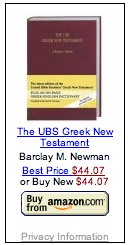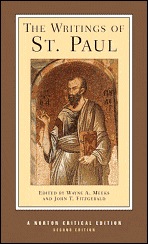The Shack: A Review (sorry I couldn't think of a more clever title, but all the good ones have already been used)
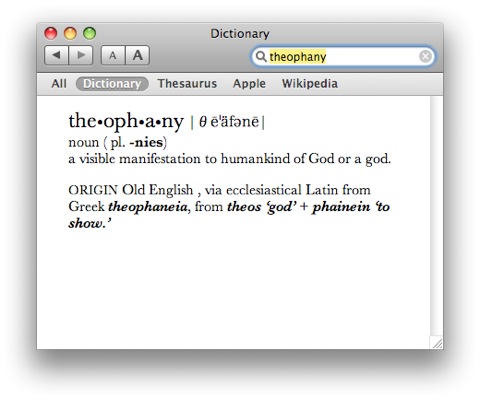
One day Abraham was sitting at the entrance to his tent during the hottest part of the day. He looked up and noticed three men standing nearby. When he saw them, he ran to meet them and welcomed them, bowing low to the ground.
“My lord,” he said, “if it pleases you, stop here for a while. Rest in the shade of this tree while water is brought to wash your feet. And since you’ve honored your servant with this visit, let me prepare some food to refresh you before you continue on your journey.” “All right,” they said. “Do as you have said.”
Then a few verses later (13), in the story, the reader learns unexpectedly that one of the three visitors is God when reading “Then the LORD said to Abraham.” The all-caps designation stands in place of the divine name for God, (יהוה / Yahweh), leaving no doubt to the reader that one of the strangers is God, the same God who will appear to Moses in Exodus 3.
Ever since the early Christians began to work out the relationship of Father, Son, and Holy Spirit in what would come to be known as the Trinity, many Christian writers, teachers, and preachers over the last two millennia have looked at Genesis 18 and have suggested that the three individuals who visited Abraham and his family at the Oaks of Mamre were, in fact, the three persons of the Trinity in physical manifestations. This is what is known in theological terms as a theophany, a physical manifestation of God for the purpose of relating to human beings.
The problem is that the Genesis text never specifically states the identity of the two other than beyond the one of them already identified as Yahweh. While some would like to equate Yahweh with God the Father exclusively, traditional Christian doctrine doesn’t make this claim either. In fact, from a Christian perspective, Yahweh is not limited to one person of the Trinity. See for example John 8:58, where Jesus essentially tells the Jewish leaders that they are in the presence of the same “person” who appeared to Moses at the burning bush in Exodus 3, but that doesn’t imply that the Father and Holy Spirit weren’t there, too.
The passage with Abraham in Genesis 18 is subtle. When encountering it for the first time, the reader/hearer may not expect initially that God is one of the visitors, although it is foreshadowed at the beginning of v. 1. Whether the other men who were present with Abraham were theophanies of the other persons of the Trinity or whether they were angels or even someone else, we simply don’t know because we weren’t privy to the entire conversation. And that’s the way the Bible generally works--less is more, if you will.
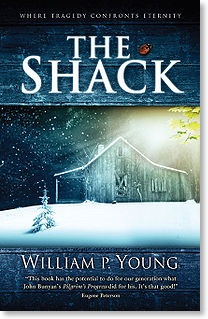
That’s a very brief synopsis of the book, and my hunch is--since I’m so late to the game with this review--that most readers of This Lamp know all this anyway. I’m writing this review because I’ve received questions and emails since last Fall asking what I think of The Shack. By simply being able to point people to this page, I won’t have to repeat myself so much.
Kathy and I listened to the unabridged audio version of The Shack in December while we were traveling to Louisiana and back for Christmas. I don’t own a physical copy of the book, so I won’t be able to quote it verbatim, but it doesn’t really matter. I can still offer my general impression and point readers to other sources.
You need to know, up front, that I don’t think very highly of The Shack on multiple levels. I am certain that some of you will think I’m just being theologically picky, that I’ve let formal study of the Bible make me into some kind of doctrinal do gooder who can’t allow my imagination to see God in creative ways. If you think that, you simply don’t know me well. But don’t just ask me about this book, ask my wife Kathy. She may be less charitable than me.
But let me start by being charitable. Let me start by saying that William P. Young seems to be a really great fellow. At the end of our audio version of The Shack we were able to listen to an extended interview with Young. His motives seem to be nothing more than sincere. At the very least, he is certainly the benefactor of fortunate circumstances with the sale of The Shack into the millions of copies at this point, and no doubt many of the publishers who turned him down greatly regret doing so.
Furthermore, I don’t think that Young was attempting to be unbiblical, let alone introduce heresy into his novel. Nevertheless, he did.
So much has been written about the doctrinal error in The Shack, I started not to even comment on it. One can easily run a Google search for “The Shack” and “heresy” and find a multitude of pages, so I doubt I could top what has already been done. However, let me reproduce here three of Norman Geisler’s fourteen errors in The Shack. Geisler may not win an award for best webpage layout, but he offers a strong theological critique for Young’s work.
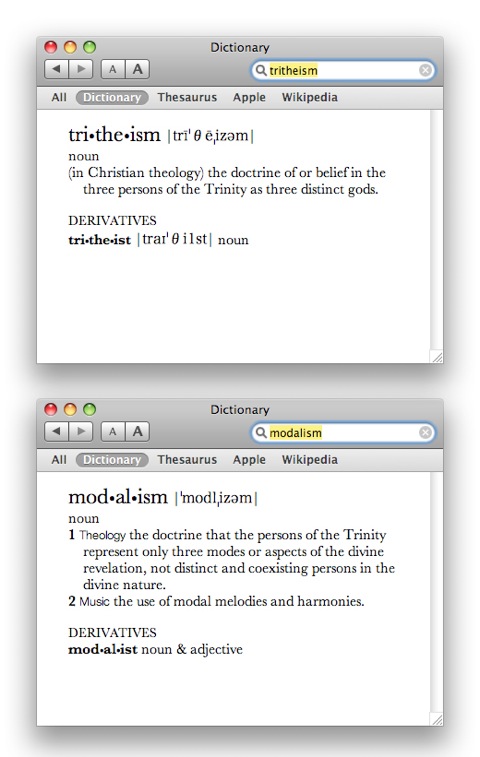
In addition to an errant view of Scripture, The Shack has an unorthodox view of the Trinity. God appears as three separate persons (in three separate bodies) which seems to support Tritheism in spite of the fact that the author denies Tritheism (“We are not three gods” ) and Modalism (“We are not talking about One God with three attitudes”—p. 100). Nonetheless, Young departs from the essential nature of God for a social relationship among the members of the Trinity. He wrongly stresses the plurality of God as three separate persons: God the Father appears as an “African American woman” (80); Jesus appears as a Middle Eastern worker (82). The Holy Spirit is represented as “a small, distinctively Asian woman” (82). And according to Young, the unity of God is not in one essence (nature), as the orthodox view holds. Rather, it is a social union of three separate persons. Besides the false teaching that God the Father and the Holy Spirit have physical bodies (since “God is spirit”—Jn. 4:24), the members of the Trinity are not separate persons (as The Shack portrays them); they are only distinct persons in one divine nature. Just as a triangle has three distinct corners, yet is one triangle. It is not three separate corners (for then it would not be a triangle if the corners were separated from it), Even so, God is one in essence but has three distinct (but inseparable) Persons: Father, Son, and Holy Spirit.
Problem Five: An Unbiblical View of Punishing Sin
Another claim is that God does not need to punish sin. He states, “At that, Papa stopped her preparations and turned toward Mack. He could see a deep sadness in her eyes. ‘I am not who you think I am, Mackenzie. I don’t need to punish people for sin. Sin is its own punishment, devouring you from the inside. It is not my purpose to punish it; it’s my joy to cure it’” (119). As welcoming as this message may be, it at best reveals a dangerously imbalanced understanding of God. For in addition to being loving and kind, God is also holy and just. Indeed, because He is just He must punish sin. The Bible explicitly says that” the soul that sins shall die” (Eze. 18:2). “I am holy, says the Lord” (Lev. 11:44). He is so holy that Habakkuk says of God, “You…are of purer eyes than to see evil and cannot look at wrong…” (Hab. 1:13). Romans 6:23 declares: “The wages of sin is death….” And Paul added, “‘Vengeance is mine, I will repay’ says the Lord” (Rom. 12:19).
In short, The Shack presents lop-sided view of God as love but not justice. This view of a God who will not punish sin undermines the central message of Christianity—that Christ died for our sins (1 Cor. 15:1f.) and rose from the dead. Indeed, some emergent Church leaders have given a more frontal and near blasphemous attack on the sacrificial atonement of Christ, calling it a “form of cosmic child abuse—a vengeful father, punishing his son for offences he has not even committed” (Steve Chalke, The Lost Message of Jesus, 184). Such is the end of the logic that denies an awesomely holy God who cannot tolerate sin was satisfied (propitiated) on behalf of our sin (1 Jn. 2:1). For Christ paid the penalty for us, “being made sin for us that we might be made the righteousness of God through him” (2 Cor. 5:21), “suffering the just for the unjust that He might bring us to God” (1 Pet. 3:18).
Problem Six: A False View of the Incarnation
Another area of concern is a false view of the person and work of Christ. The book states, “When we three spoke ourself into human existence as the Son of God, we became fully human. We also chose to embrace all the limitations that this entailed. Even though we have always been present in this universe, we now became flesh and blood” (98). However, this is a serious misunderstanding of the Incarnation of Christ. The whole Trinity was not incarnated. Only the Son was (Jn. 1:14), and in His case deity did not become humanity but the Second Person of the Godhead assumed a human nature in addition to His divine nature. Neither the Father nor Holy Spirit (who are pure spirit--John 4:24) became human, only the Son did.
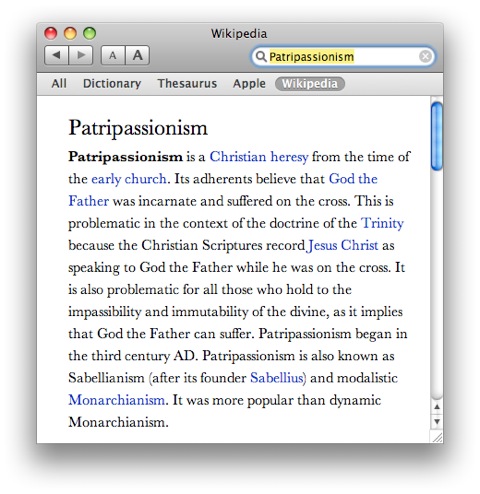
On a completely different level, The Shack doesn’t work for me simply because overall, it’s not good literature. Let me qualify that statement. I’ll admit up front that everything leading up to Mack’s entering the shack where his dialogue with God begins kept my keen attention. It was a tragic story about the loss of his daughter and his estrangement from God, and one that I was really interested in. And I would also point to Mack’s vision (or whatever you want to call it) in which he was reconciled to his earthly father--powerful stuff.
Unfortunately, it’s the most significant part of the book--his encounter and dialogue with the persons of the Godhead--which not only are full of bad theology, but really are the weakest narrative parts of the whole story. The dialogue is overblown, repetitive, and pretentious. If you want good theological dialogue, I recommend Peter Kreeft (see here
and here
Besides that, there is too much content in the story that’s just plain weird or cheesy. The ongoing joke about Mack’s potential flatulence causing Papa (God the Father, as you’ll remember) to refuse him any more greens at dinner was more weird than humorous to both Kathy and me. Papa laughing at Jesus and calling him “Butterfingers” when he let slip a casserole dish, letting it come crashing to the floor seemed not only odd, but also introduced another doctrinal error. Essentially Young has Jesus err, something the Bible says he was incapable of doing. Would this also mean that Jesus occasionally smashed his thumb during carpentry work in Nazareth? Such a thought or question might not even matter to most reading this, but the implications start to get unsettling.
I had to grimace and shake my head when Mack opened his nightstand drawer in his bedroom at the shack and found a Gideon’s Bible. Ha ha ha. To me, that’s the kind of “gimmick” that distracts more than adds to the story. Further, when Jesus and Mack needed to walk to the other side of the lake, I knew it was coming before Young said it--sure enough, they would walk across the water! What else would you do if you were with Jesus? It’s these kind of gee whiz moments that I felt were bordering on immature and simply not needed in the story.
And should I even go into how Mack’s conversations with Papa in the kitchen while she was cooking was a blatant rip-off of Neo in The Matrix conversing with the Oracle in her kitchen while she made cookies? Should I question how Mack’s character, who was supposedly seminary trained, could ask the most inane questions of God, that any student who went to an institution worth its salt, or for that matter, any laymen who’d spent any decent amount of time with the Bible should know?
What boggles my mind is that a number of well-respected individuals do consider The Shack to be good literature. One endorsement comes from Eugene Peterson, an individual I admire very much and happen to be reading currently. Of The Shack, Peterson says this:
When the imagination of a writer and the passion of a theologian cross-fertilize the result is a novel on the order of The Shack. This book has the potential to do for our generation what John Bunyan's Pilgrim's Progress did for his. It's that good!
The Shack equated to Pilgrim’s Progress? Really? Seriously? I read that and it makes me wonder if Peterson actually read the book. I don’t mean that as an insult against him. Regularly, well known individuals are approached by publishers, given a synopsis of a book, and then an already written endorsement for the individual to sign. Most of the endorsements you see on the back covers of books are handled this way. Endorsements should be evaluated with more than a grain of salt.
Yet, I could see why someone like Peterson would appreciate the concept of The Shack simply because of the way he sees the communal nature of the Trinity. In Christ Plays in Ten Thousand Places
Trinity understands God as three-personed: Father, Son, and Holy Spirit, God in community, each “person” in active communion with others. We are given an understanding of God that is most emphatically personal and interpersonal. God is nothing if not personal. If God is revealed as personal, the only way that God can be known is in personal response. We need to know this. It is the easiest thing in the world to use words as a kind of abstract truth or principle, to deal with the gospel as information. Trinity prevents us from doing this.
The premise of The Shack promises what Peterson describes above; unfortunately it does not satisfyingly deliver. And that’s the key question--does The Shack really satisfy? Ask yourself that if you really liked the book. Strip away the way the persons of the Godhead were presented in very likable portrayals. Strip away the meal time conversations, the walking on water across the lake, and ask yourself if you really know God better.
Here’s the problem: ultimately we are not given real answers by God in The Shack. Rather we are given answers as best as William P. Young understands God and can speak for God. See, in any work of fiction, the writer is ultimately God. The writer sets the events in an absolute predetermined way, and all characters--even God himself as a character--will speak and behave only in how the true god of the story (the writer) thinks they should. I’m not trying to be harsh here, but I’m trying to remind readers of this very important fact: The Shack does not contain a message from God; it contains a message about God from the writer--a writer whom to my knowledge hasn’t received any more revelation from the real God than you or me. This writer did the best job he knew how, but ultimately, he doesn’t really give us anything new and certainly nothing revelatory about God and our relationship to him.
And frankly, it saddens me that so many have so uncritically embraced the book. You don’t have to be a theologian to see problems in The Shack. Kathy does not consider herself a theologian at all, but as we were listening to the audio version, she offered a blow by blow commentary of its weaknesses as we listened. The book right now has almost 3000 reviews on Amazon.com. One reviewer, who said he liked the book, but gave it only three out of five stars noted that he was very concerned by the “book being embraced with nothing but naive, uncritical, and untempered enthusiasm.” This concerns me as well.
My friend Todd Benkert has written about the popularity of The Shack, trying to figure out why it’s been so very popular for a self-published book. In his blog post, “One More Post about The Shack with ‘Something Else’ to Consider,” Todd offers this theory:
The Shack offers people what the church, by and large, does not--hope for and acceptance of messed up people.
Mack is a messed up person. He has real hurts. He has experienced real pain. He does not act and think the way a Christian ought to act and think. In fact, he questions and even blames God for what has happened to him. People relate to Mack. They relate to the pain and hurt and struggle and questions Mack has. And they find from Papa, Jesus, and Sarayu the kind of understanding and acceptance that is, for whatever reason, missing in the church.
Todd may very well be on to something. My concern is that while the Church does indeed need to get its act together in regard to people who are hurting, The Shack is not really a solution. It’s a band aid for a much more serious kind of wound. Think about this really-- if you knew someone who had lost a child through murder or some other tragic means, would you really consider giving The Shack to a hurting person to read? I cannot fathom that idea.
And I know that many people who’ve appreciated The Shack feel as if they can relate to God better after reading the book. But if someone wants to know what God is like, rather than handing them a copy of The Shack, (and pardon me if this sounds unnecessarily church) I’d give them a copy of the New Testament. In the Gospels, we learn how God “became human and made his home among us.” In doing so, not only did he provide a way for us to be reconciled to him, he also “put on a face” in the person of Jesus. You want to know what God is like? Read the Gospels. Do you want to know specifically what the Father and Son are like and how they interrelate? Engage in a good study of Jesus’ parables. If you’re curious to know how to relate to the Holy Spirit, read the Book of Acts. God has revealed himself already through his Son and through his written Word. If you still cannot relate, it may be your translation of the Bible. Be sure you are reading something translated in the last decade or so in normal, contemporary English.
I have no trouble recommending the New Testament as a way of relating to God. That’s one of its major functions. But sadly, I cannot recommend The Shack under any circumstances or in any contexts.
For Further Reading:
• “The Shack: Helpful or Heretical? A Critical Review by Norman Geisler and Bill Roach”
Geisler and Roach outline 14 primary theological blunders made in The Shack. Some of these are more significant than others, but they still make a compelling case.
• “A Look at The Shack” (The Albert Mohler Radio Program)
You can download this MP3 file and listen to it on your iPod or iPhone while driving to work.
Lest anyone accuse me of not giving equal time, here are two reviews a little more positive worth considering:
• “Reading in Good Faith” by Derek Keefe
Acknowledging there are problems in the book, Derek Keefe finds some value in The Shack that the church can benefit from.
• “The Shack by King David” by Gordon MacDonald
MacDonald wonders if anyone took offense when David portrayed God as a smelly, dirty shepherd in Psalm 23.
The UBS Greek New Testament: A Readers Edition (A Hands-On, Comparative Review)
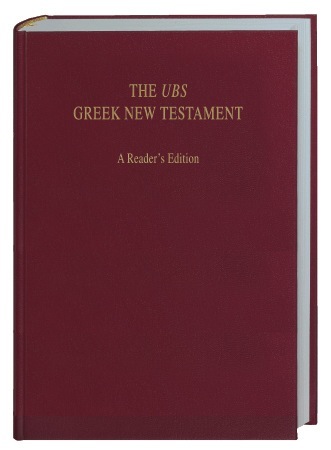
If you haven't read it already, I highly recommend that you see my earlier review of A Reader's Greek New Testament, 2nd Edition from Zondervan for a greater context in understanding this review. If you don't have time to do that, there are four things you should know right up front:
- The UBS Greek New Testament: A Reader's Edition (henceforth UBSRE), is similar in nature to Zondervan's A Reader's Greek New Testament (RGNT from this point forward) which has been published in two separate editions. The first was based upon the Greek text underlying the NIV, and the second is based upon the Greek text underlying the TNIV. All three of these New Testaments include a Greek text with a vocabulary apparatus at the bottom of the page containing definitions for all words that occur less than 30 times in the New Testament. The purpose of such an edition is to allow the reader with at minimum a basic foundation of Greek study to simply read the New Testament in Greek without having to constantly consult a lexicon for words not in one's working knowledge.
- As I explained in the previous review of the RGNT2, although I originally bought the Zondervan RGNT1 for the novelty of having the underlying NIV text, I actually found the volume quite useful, especially as a tool to throw into my book bag that I carry to church on Sundays. I found the idea of a Reader's New Testament in Greek with the vocabulary apparatus is extremely handy when I simply needed to consult the text and wasn't worried about text critical issue or didn't have the time to look up complete definitions in my BDAG lexicon.
- I was never fond of the italic text in the RGNT1, but it was bearable. I was extremely disappointed in the release of the RGNT2 in that although the text was changed to a non-italic font, it used a style with thinner character strokes that actually made the text more difficult to read in my opinion.
- Finally, about a year or so ago, a professor at a seminary extension contacted me wanting to know if I had heard whether the RGNT was being discontinued due to threat of a lawsuit from the United Bible Societies or the German Bible Society. I could not confirm any such lawsuit at the time or that the RGNT was being taken off the market (it was not). However, I did confirm from an off-the-record source recently that there was talk of an actual lawsuit, but it was deemed that since the standard eclectic Greek New Testament is based upon public domain ancient manuscripts, such a suit would not be able to stand up in court.
I'm happy to report that nothing ever came of the lawsuit talk. I would have greatly disappointed (especially in light of 1 Cor 6:1ff) if one Bible publisher had decided to sue another Bible publisher. Rather, the German Bible Society decided to create their own edition of a Greek New Testament similar to Zondervan's RGNT. The UBS version, however, is based upon the UBS Greek New Testament, fourth revised edition. The main features of the UBSRE include the following:
- Translation of all vocabulary items occurring 30 times or less in the New Testament at the bottom of the page
- Translations given according to context
- Definitions of idiomatic word combinations
- Grammatical analysis of all difficult verb forms
- Reader-friendly layout enabling the reader to transfer easily from text to dictionary and vice versa
- An appendix providing translations of all vocabulary items occurring more than 30 times in the New Testament
- The maps from the USB Greek New Testament.
I find it impossible to review the UBSRE without reference to Zondervan's RGNT, so I would prefer to offer a comparative review. From the outset, the immediate difference between these two is size. Although, both have about the same dimensions in height and width (both volumes are around 6" x 9"), the UBSRE is essentially twice as thick as the RGNT. Zondervan's product page for the RGNT states that it contains 576 pages, while the German Bible Society's product pages lists the UBSRE at 712 pages. So why is the UBSRE twice is thick as the competing product, even though it is less than 200 pages longer? Well, it has to do with the very thin paper and space-conserving format used in the RGNT, but I'll write more about that in a moment.

Admittedly, I like the soft, leather-like Italian DuoTone cover on the RGNT better than the hardcover binding of the UBSRE. The Zondervan product feels like a Bible, while the UBS edition feels like a book. The UBSRE is bound in what has become the signature burgundy cover with gold lettering that is used with most editions of the UBS Greek New Testament. However, I know that they also produce flexible covers, and I believe one would be appropriate for this edition.
Nevertheless, it's what's inside that counts, and this is where the UBS shines. I'll get to the layout issues in a moment, but first a few comments on the vocabulary apparatus. The apparatus itself is referred to in the introduction and on promotional materials as a "Running Greek-English Dictionary." The RGNT has this, too, of course, but the UBS edition may just be better. The definitions have been adapted from Barclay Newman's Concise Greek-English Dictionary of the New Testament contained in many UBS editions of the Greek New Testament. Of course, because of space, the definitions have been shortened based upon the context. Therefore, the the contextual decision may theoretically imply some amount of interpretation upon the editor's part, but this would not be any different from using Trenchard's glosses in the RGNT. Further, the running dictionary is not meant to replace use of a lexicon, but merely to allow quick access to the meaning of the text in certain contexts.
The UBSRE also breaks with the Zondervan editions in that it offers grammatical help on what the editors consider more difficult forms. So for instance, in John 1:42, both the UBSRE and the RGNT offer a definition for ἐμβλέψας. The RGNT: "ἐμβλέπω, I look at, consider." The UBSRE: "ἐμβλέπω aor act ptc m.s.nom, look straight at." For many readers, this extra grammatical information is going to be very helpful.
Like the RGNT2, the UBSRE also offers a mini glossary of Greek vocabulary words occuring more than 30 times (the ones that don't get listed with the text) in case the reader simply forgets what shoudl be a memorized word. But this is also a place where the two editions differ greatly. The word list in the RGNT2 is based on Warren C. Trenchard's Complete Vocabulary Guide to the Greek New Testament, so it's definitions are fairly short as one would expect. So, for instance, if one were to look up ἀγαθός in the RGNT2 appendix, would would find this entry: "ἀγαθός, ή, όν (102) good" (the numeral indicates how many times the word occurs in the Greek NT). However, because the definition appendix in the UBSRE bases its entries on Barclay Newman's dictionary, one will find a much more detailed entry: "ἀγαθός, ή, όν good; useful, satisfactory for one’s (its) purpose, fitting, beneficial; sound (of trees), fertile (of soil), happy (of days); in a moral sense upright, just; kind, generous; clear (of conscience); perfect, inherently good (of God); τὸ ἀγαθόν the good, what is good; what is right or upright; what is beneficial or advantageous; τὰ ἀγαθά goods, possessions; good things (Lk 16:25); good deeds (Jn 5:29)." That's quite a difference, but to be fair, one could argue that the RGNT2 offers the most essential information with the understanding that more detail can be derived from other resources. But again, for some readers, this extra information will be seen as quite helpful. I should also point out that the glossary in the RGNT only fills a little less than six pages, while the corresponding feature in the UBSRE fills 22 pages.
This leads me to what I believe is the most significant difference between the UBSRE and the RGNT2: layout and readability. The UBSRE is simply easier to read than the RGNT2. It's font is larger and the text is laid out leaving more white space on the page. Further, the running vocabulary list in the UBSRE runs in a two-column list which allows one to easily find the word he or she is looking for.
I took my own scans of each edition for this review rather than relying on the PDFs made available from each publisher. I thought this might give a fairer comparison between each edition. If the lines don't seem quite straight, it's from a less than perfect attempt on my part to hold the volume flat on my scanner.
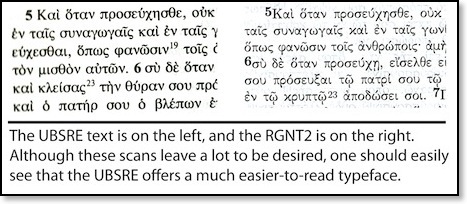
As I stated in the review of the RGNT2, part of the problem comes from my perception that Zondervan, normally a maker of quite excellent reference works, has an unhealthy preoccupation with thinline Bibles. Since the RGNT is a New Testament, someone in marketing or layout and design must have suggested than a thinline form factor be adopted. I'll be the first to admit, that the RGNT fits much more nicely in the hand than the UBSRE. However, this is strictly form over function. The UBSRE doesn't suffer from small print, cramped text, or near as much bleed through (which is even evident in the above samples) as the RGNT2. This issue is also apparent when you look at a full page spread of each edition.
[Note that neither of the scans below captured the full margins of either edition since my scanner space was smaller than a full page spread of either edition.]
First, the RGNT2 (click on the image to get a larger, more detailed view).
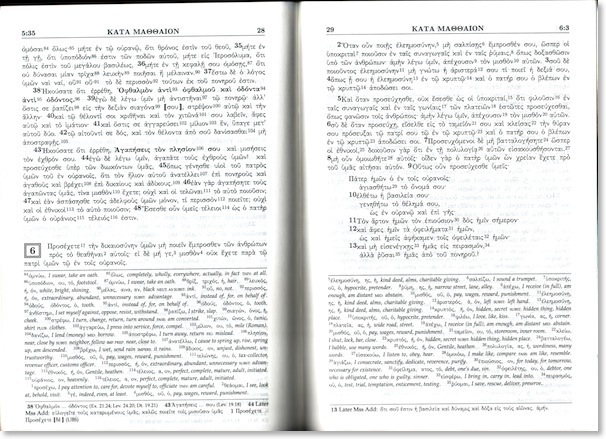
And now, the UBSRE (again, click on the image to see a larger, more detailed view):
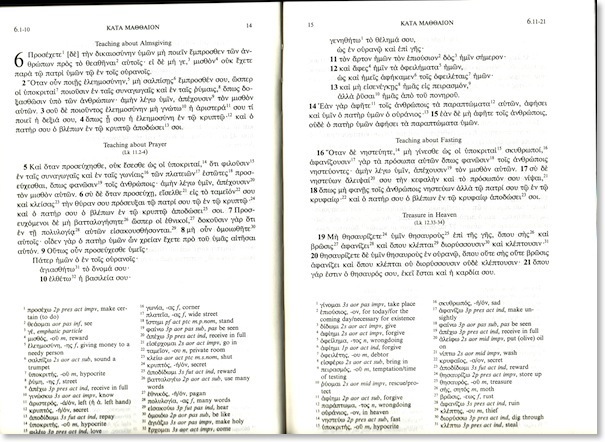
In my opinion, the UBSRE is much more inviting. Section headings separate pericopes, and parallel passages in other gospels are also noted. Of course some people prefer a straight text without section headings. If this is the case, the RGNT may be preferred to those readers. Finally, finding the definition of a word in the UBSRE is made much simpler and quicker with the two columns, rather than hunting through the paragraphed text of the RGNT's apparatus.
WHAT'S MISSING?
Not much. There's very little in the RGNT2 that's missing in the UBSRE. However, I felt the Scripture references for OT quotations in the RGNT2 were a very welcome addition, and one that the reader will not find in the UBSRE. The maps are a bit nicer in the RGNT2 than the standard UBS maps. The RGNT2 also added a few, sparse textual notes in addition those that referenced divergences from the UBS text. The reader of the UBSRE will still need to consult a more traditional edition to see textual issues.
Something should also be said about price. The UBSRE is significantly more expensive than the RGNT. I've stated for a long time that UBS prices were out of control, and this edition is no different. Even with discounts at places like Amazon or CBD, one can expect to pay about $20 more for the UBSRE over the price of the RGNT.
FINAL EVALUATION
Although initially, I was very excited about the release of the RGNT2 and its promised improvements over the first edition, I was quite disappointed in the final product. Yes, the thinline aspect of the RGNT2 might initially seem like a bonus over the twice-as-thick UBSRE, but in actual use, function simply wins out over form for me. The UBSRE is a better product because the designers of it did not choose to take shortcuts necessary to create a thinner form factor. From what I've heard, the RGNT had been greatly cutting into the sales of UBS/NA Greek New Testaments over the past few years, and the UBSRE is nothing less than a counter strike, and a significant one at that.
One last thing. If you read my review of the RGNT2, you'll remember I lamented that a ribbon marker was missing, in spite of the fact that one had been promised in early promotions, and even listed as a new feature on early shots of the box cover. Well, potential purchasers of the UBSRE will be glad to know that it does, in fact, come with a ribbon marker. Admittedly a minor detail, but handy for any reader, nonetheless.
First Look: A Reader's Greek New Testament, Second/Revised Edition
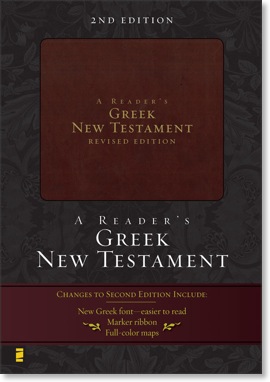
SOME BACKGROUND: THE FIRST EDITION
I've always found A Reader's Greek New Testament (RGNT from this point forward) to be an extremely practical resource. The RGNT addresses the issue that while there are over 5,000 distinct words in the Greek NT, the reality is that many of this words only occur a few times or even in single occurances. While it's an admirable goal for a student of Greek to memorize every word, it's not a reality for most. Most introductory grammars, in fact, only cover a little over 300 words, but these words occur so frequently that they account for roughly 80 of the entire New Testament. But that remaining 20% is still enough from keeping the average person who has a familiarity with Greek from sitting down and reading the New Testament in its original language as easily as one might read an English translation. In fact, in my experience and observation, I've known personally of only about two or three people who can really read the Greek NT without stumbling. Oh, sure, the dirty little secret is that any of us can read a passage just fine when we've taken the time to work through it ahead of time. But as soon as someone asks us a question about a different passage--one that we haven't prepared beforehand, we stumble and stammer as we try to read it in a quick and efficient manner.
The RGNT is noted for including lexical forms for all words of the Greek New Testament that occur 30 times or less. If this sounds like a crutch, think again. The reader still has to know his or her Greek grammar fairly well to use this resource. In fact, I tend to carry the first edition of the RGNT with me to church on Sundays. If I need to look up something quickly, and come across a word that's not part of my working vocabulary, I can look at the footnote at the bottom of the page. It's not realistic for me to carry a lexicon with me to church, and I usually don't have my MacBook so that I can access such tools in Accordance. Perhaps one day, I'll make time to memorize all 5000+ words in the Greek NT, but for right now it's not a practical goal and the RGNT is an ideal solution.
The other distinct feature of the RGNT first edition has to do with its textual basis. Most might assume that this is simply an edition of the current UBS/NA eclectic Greek text with a special apparatus. Not so. The Greek text in this edition is actually one that has been retrofitted, so to speak, to match the text that underpins the New International Version. The reality is that every translation committee makes decisions that sometimes causes them to choose a different textual route than the majority opinion of the UBS/NA committees. The RGNT first edition has about 200 instances, all noted in the footnotes, where its text differs from the standard text.
IMPROVEMENTS/CHANGES IN THE SECOND EDITION
New Greek font. I don't know if the font itself is actually a different font, but the main difference from the first edition is that the text in the second edition is not in italics. And I say, "Thank goodness!" My major complaint about the first edition of the RGNT is the italicized text that is extremely difficult to read. I have no idea why some publishers of Greek texts like to do this. The UBS 4th edition Greek NT uses a horribly thin italicized text also making it difficult to read. Thankfully, Zondervan changed this policy in the RGNT 2nd edition.
However, the font itself does look slightly smaller than the original edition. I've made a comparison in the graphic below that displays the first page of Matthew's Gospel on the left in the first edition and with the second edition on the right (note that the image below is not actual size).
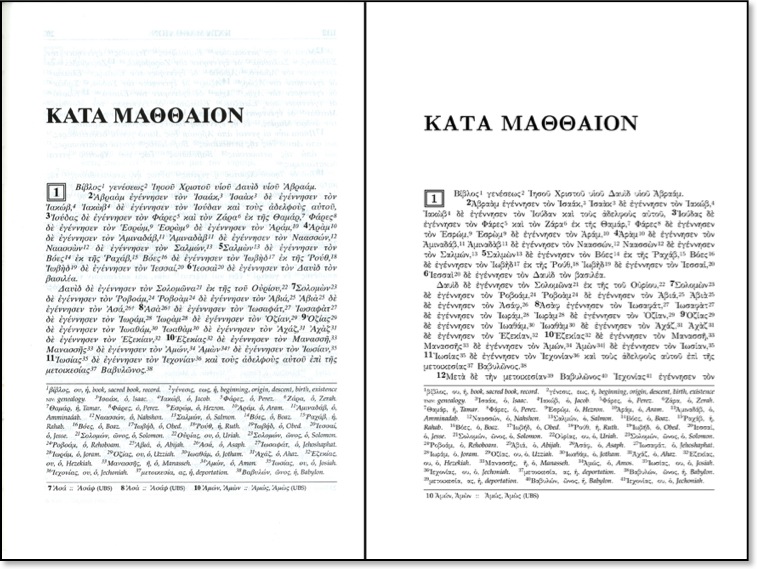
The observant reader may notice that there's slightly more text (most of Matt 1:12) on the second edition page. Therefore, the font is either tighter or smaller. Zondervan offers a PDF sample of the RGNT2 featuring the first five pages of Matthew. The second edition ends with Matt 3:17 while the equivalent page in the fist edition ends with 3:15. Two verses--is that a big deal? Probably not, but there is definitely an attempt to use fewer pages. Why? Because while there are more features in the RGNT2, but there are actually fewer pages than the first edition. Therefore, an attempt was made to conserve space. And while I wish Zondervan had not chosen to use a tighter/smaller font, I will say that regardless, the new text is much easier to read than the italicized text of the first edition.
But that brings us to another issue, and frequent readers of This Lamp will have to pardon a familiar complaint that I've discussed many times before. This New Testament, (presumably) like its predecessor is a thinline. How do I know this? Well, in spite of the fact that complete measurements have not been released, we do know a few things. I'm guessing the dimensions are a bit wider because the outer margin on each page is wider (see more below). We also know that although there is about a twenty page difference in the two editions, the weight is comparable (1.065 lbs. for the first edition vs. 1 lb. for the second edition). Thickness measurements for the second edition have not been released, but the first edition is 7/10 of an inch thick. Since the two editions weigh virtually the same, I can only assume that the second edition will be just as thin.

Personally, I hope that one day, publishers will get over their infatuation with thin Bibles and realize that the target market for a resource like this does not mind having a book that is somewhere between one inch and one and a half inches in thickness. I'm sorry, but cramming 576 pages into 7/10 of an inch is ridiculous.
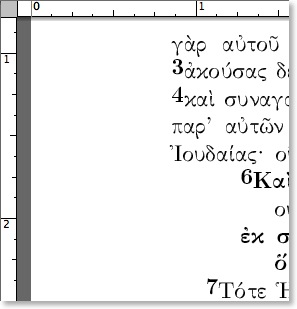
Again, this is an area where I with publishers would realize that those who buy products such as the RGNT appreciate not just thicker paper, but also wide margins for making notes, Regardless, whereas, the first edition's anemic margins were useless for any annotations, the new wider margins begin to approach a minimum width for note-taking,
Mlnl-Lexlcon. For those occasions when the reader forgels one of those words that occur more than 30 times, a new mini-lexicon has been added, presumably in the back of the RGNT.
Maps. Four new color maps have been added to the second edition of the RGNT. Already UBS/NA Greek New Testaments tend to have basic contextual maps inside the front and back covers. With the addition of these maps to the RGNT, this resource begins to take the feel of a standard reference tool and even a one-stop instrument for public use.
And the rest. Like the first edition, the new RGNT comes in an Italian Duo-Tone binding, I've stated before that I like this material just as much as actual leather. Assuming that these covers are going to hold up over decades-long use, I find them to be a very adequate substitute for real leather, especially if this keeps the price down. Perhaps Zondervan could put a disclaimer on the copyright page: "No cows were harmed in the publishing of this New Testament."
And of of course, the RGNT second edition will continue to offer lexical forms of words that occur less than 30 times in the Greek NT as well as noting where the text diverges from the UBS/NA texts. I'm pleased that they continue to keep these notes on the same page as the NT text, in footnote fashion, rather than by some other means.
I'll have more to say about the RGNT2 after I get my hands on one in November, Butfrom what l can already determine, it is already looking to be a great improvement over what was already a very practical and useful resource.
Bible Note-Taking: My Method
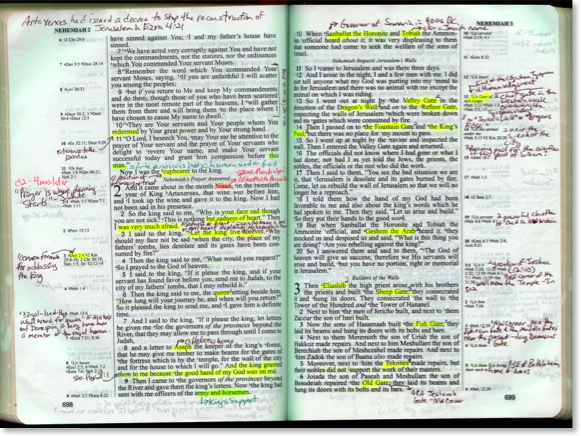
I actually developed it while I was in college, and although I've tweaked it along the way here and there, it's not overly changed from the way it was years ago. I have to admit that the actual structure is based on the colors available in a pack of Stabilo Boss Dry Highlighters. The pack came in five colors. I never figured out what to do with the orange, so I used it elsewhere. However, here is how I arranged my categories:
YELLOW = General and miscellaneous notes that do not fall into other categories.
RED = Dates, chronology, date of composition
GREEN = symbolism, metaphor, literary features
BLUE = Messianic, Christological
With each of the dry highlighters, I use a corresponding pen for my annotations with the exception of the first category for which I use a black pen. In other words, I highlight in yellow, but the corresponding note is in black, unlike the other colors for which I have matching highlighter and pens.
The main Bible I take notes in is a NASB wide-margin single column reference Bible from Foundation Publications. I would be willing to use a more contemporary version such as the TNIV or NLT, but no adequate wide margin Bible is available in these translations. I make these annotations whenever I study a passage (using commentaries and other reference works) for personal edification or teaching others. I make different kinds of notes in a Greek NT, usually grammatical issues relating to the Greek text or a gloss of a rarely used word that is not in my memorized vocabulary.
Here are some random examples of the kind of annotations I've got marked in my NASB wide-margin Bible:
GENERAL AND MISCELLANEOUS NOTES
- In Gen 45:4, I have the word alive highlighted in yellow. In the margin I have the words "meaning 'enjoying health and well-being.'" I have no idea where I got this information--probably from a commentary. I will list a source for extended notes, but not short comments like these.
- Sometimes I merely write annotations without highlighting anything specific. For instance, In the top margin above 2 Sam 13, I have "reminder" bullets: • Absalom and Tamar were David's children by Maacah, daughter of the king of Gesure; and • Amnon Was David's son by Ahinoam, the Jezruelitess.
- At Neh 4:3, I have highlighted in yellow the words "break their stone wall down." In the margin are the words, "Actually archaeological discoveries have revealed Nehemiah's wall to be four feet thick--NAC." In this case, I did note the source: the New American Commentary. I could have just as easily noted the author instead of the series, but more than likely, the series would make a more familiar reference in this case.
- At Neh 3:13, Zanoah is highlighted in yellow with the accompanying note, "13 mi. sw of Jerusalem."
- Sometimes the notes will reflect alternate translations. In Neh 5:7, I highlighted the words "I consulted with myself" and in the margin have the note "lit. 'my heart took counsel upon me.'"
- Certain books like Job are heavily annotated. In this case, I was doing personal study through Job at one point, and then I've taught the book a few times.
- In many places throughout the Bible, I'll highlight a word in yellow, and in the margin or very close to it, write the actual underlying original language word.
DATES AND CHRONOLOGICAL ISSUES
- In Jer 1:2, I highlighted in red the phrase, "the thirteenth year of his reign." The corresponding note (written in red ink) says 627 BC.
- I highlighted in red the Hebrew month "Nisan" with the corresponding note "spans March-April; 1st month of the Persian year." Similarly at Neh 9:1, I highlighted the phrase "the twenty-fourth day of this month" with the annotation "Oct 30, 445 BC."
- I have a note in red at Acts 6 that these events occur five years after Pentecost.
- At the beginning of books, I often try to list suggested dates of composition. For instance in Matthew, I have a number of suggestions including on the more conservative side: "60's <70" from Carson, Moo, & Morris' NT Intro and "After 70" from Kümmel's more progressive NT Intro. Because these types of annotations come at the beginning of the book, I sometimes write other introductory notes in red as well such as suggested authors, but I don't do this consistently, it seems.
- I occasionally use red for brief outlines and structural notes.
SYMBOLISM/METAPHOR/LITERARY
- I highlighted "with fasting, in sackcloth and with dirt upon them" in green and my corresponding note written in green says "mourning and humility." This kind of note seems unnecessary after a while. I simply "know" that kind of information. Do I really need to make a note of it? And yet, I tend to add that kind of notation anyway for teaching purposes as it reminds me to mention it in an instructural setting.
- In Job 1:2 I have highlighted "Seven sons and three daughters" with the annotation "The symbolism of the numbers imply that Job had an ideal family." This kind of note gets a lot of play in a book like Revelation, where I have quite a bit of green.
- In Psalm 74:19, turtledove is highlighted with the simple annotation "Israel."
- A passage like Eccl 12:3-6 is loaded with symbols. "watchmen of the house" = arms, "mighty men" = legs, "grinding ones" = teeth, etc. I have all of these highlighted in green with accompanying annotations written in green.
- I use green for the many euphemisms in a book like Song of Solomon.
MESSIANIC/CHRISTOLOGICAL
- This turns out to be my least used color, perhaps because it could be overdone, especially in the gospels and become meaningless. Often annotations that could receive blue treatment simply get highlighted in yellow.
- Since the NASB wide margin that I use has a cross reference system, I often will highlight in blue the cross references between the testaments referred to in messianic prophecies. Surprisingly, often I find that the references aren't included both ways and I will have to write one of them in using a blue pen.
- In Rev 5:5, I have Lion highlighted in blue with an annotation written in blue that says "conquering warrior messiah." Then in v. 6, I have the accompanying Lamb highlighted in blue with the note "sacrificial death; links the Messiah to the passover lamb." I also have a note written in blue with v. 6, but not directly related to anything specifically highlighted, that says "Here John joins the OT Davidic Messiah and the Suffering Servant of Isaiah (Isa 52-53)." I really should have listed my source for that because I doubt it was my own original conclusion. It may have come from John Newport's book, The Lion and the Lamb.
Obviously, there are thousands of other examples, but the above are a sampling which I believe gives the flavor for what I am doing.
The actual Stabilo Boss Dry Highlighters are no longer made, but are still available on eBay. I have stocked up on enough to last for a very long time. The dry highlighters I usually see in stores these days are the Staedtler dry highlighters. To me these are a perfectly suitable replacement, except for the yellow pencil which makes me continue to seek out the older highlighters.
For years, I used ballpoint pens for my corresponding notes, with green ballpoints always the most difficult to come by. Noticing that some of my oldest notes were starting to bleed through, and I began to look for something else. A number of readers for this blog suggested the Pigma Micron pens. These are what I use exclusively in my Bibles now, and having experimented with different nib sizes, settled on a 01 point for writing in my Bibles. I like these pens so much, I use the larger nibs for grading papers and writing in my Moleskine journal.
I also discovered that Pigma Micron has a brown pen. I like the color brown for a pen, having used brown ink the last couple of years in the Mont Blanc I carry with me everyday. I incorporated brown into my Bible notetaking recently (the first new color added since the originals) by using it as the color for notable quotations that I sometimes find room for in the top or bottom margins of the page.
When I was teaching out of the NASB in which I take notes, I could truly say this was my primary Bible. At one time, I was studying with this Bible, teaching from it, and occasionally preaching from it. I really feel there's great value in using the same Bible for both preparation and delivery. Because I have chosen to teach from a more contemporary version, I have to leave my NASB at home and rely on typed notes and any annotations I may have had room to write in the limited space of the Bible I've been using. Of course, I always taught from pages of notes as well anyway, but in conjunction with the annotations in my Bible. Obviously, not everything could fit into a Bible's margins. But not having the same Bible for both phases definitely has its drawbacks.
And every Sunday morning as I pack up my bag of books to take to church, I am often tempted to chuck the contemporary versions and go back to my trusty NASB instead. Again, I've been willing for two years to make a complete jump to newer translations. The publishers just don't seem to want to comply.
Review: Writing of St. Paul, 2nd edition by Meeks & Fitzgerald
Below is a guest review from This Lamp reader and occasional contributor, Larry.
Writings of St. Paul, 2nd ed., Edited by Wayne Meeks and John Fitzgerald, (Norton 2007) (Amazon price $14.50
[Note: because of the recent appearance of this work, I’ve decided to change my order of presentation of academic study Bible reviews. Previous reviews discussed the (Oxford) Jewish Study Bible and the New Oxford Annotated Study Bible, 3rd Augmented Edition. See my introductory remarks in my first review.]
There are many ways to read the Bible. One way is to attempt to understand the “original authorial intent” of the Bible – often called a historical-critical reading. A related, but distinct way is to attempt to chart the way that various readers have understood the Bible. Both of these methods have value, but in the complex portions of Scripture, we may never have a clear consensus of the meaning of Scripture, so the most we can hope for is to understand how different groups have read it. The Writings of St. Paul (2nd edition) (WSP) is an excellent introduction to reading the writings of Paul through the eyes of groups varying from his contemporaries to our contemporaries.
The Pauline Epistles form a genre unto themselves – aside from Jesus (who is the subject of the Christian Scriptures but not the direct author or any book in it), Paul is the leading character in the Greek writings of the Bible. Seven letters are clearly written by him, another six letters are attributed to him, there is an extensive New Testament apocryphal literature attributed to Paul, and a good portion of Acts is devoted to him. Paul may the single greatest contributor to Christian theology and the meaning of his works form the most virulent disputes in Christendom. The secondary literature on Paul – even in English – is so extensive that no single person can hope to read it all. But understanding the different ways in which Paul is interpreted is important, not only for the Christian faithful, but for anyone who wishes to understand this religious genius of Western culture.
Paul is difficult to read – his reasoning often appears inconsistent and his writing was to specific audiences who were familiar with Second Temple period Judaism or contemporary Hellenistic culture – under Roman political rule. Since most of us are not fluent in cultural references from this period, it is easy to misunderstand Paul.
Norton publishes a series of relatively inexpensive paperbacks featuring annotated texts and assorted essays with critical readings, called the Norton Critical Editions series. These are the “Criterion Editions” of the literary world – stuffed with notes and extra material. The selection of titles does not attempt to be a comprehensive survey of literature, but rather includes a variety of texts that are of interest in the undergraduate classroom. (Among the texts of interest to those in religious studies are St. Thomas Aquinas on Politics and Ethics, Newman’s Apologia Pro Vita Sua, The Epic of Giglamesh, and Dante’s Inferno.)
The Writings of St. Paul, 2nd edition (WSP) is a revision of a 1972 classic by Wayne Meeks (which is still available
The philosophy behind this work is to present the broadest possible set of views. Thus we hear from Paul’s opponents (e.g., the Jewish Christians often criticized by Paul, the Pagans) and those with radically different views of Paul (e.g., the Jews, the Gnostics). Thus this book has full representation of the opinions of heretics – and even for the faithful, this is useful; since it allows us to understand the nature of some of the disputes over Paul, both classical and modern.
The switch to the TNIV
The biggest surprise in this new edition is the textual basis – the first edition used the 1946 RSV translation (note that the first edition predated the appearance of the NIV and NRSV, although it postdated the appearance of the NEB and the NASB.) In the first edition, the editor writes (p. xi)
"The text is from the Revised Standard Version. It was chosen from the several excellent contemporary English versions now available because its relatively conservative mode of translation enables the reader to recognize certain distinctive features of Paul’s style."
The second edition uses the TNIV instead, a surprising choice since the TNIV is most closely associated with Evangelical circles. The editors write (p. xi)
“The text of the Pauline letters is from Today’s New International Version (TNIV). It was chosen from the several excellent modern versions now available ecause its relatively conservative mode of translation enables the reader to recognize certain distinctive features of Paul’s style, while still taking account of current discussions in biblical scholarship and aiming for both inclusiveness and accuracy in the representation of gender.”
Clearly issues of gender played a large role in the editors’ decision to use the TNIV. This inclusive approach forms a core desideratum of the authors, who are at pains to point out (p. 589) “whereas the first edition had no excerpts from female scholars, the second edition features contributions by seven women.” The second edition also features many more contributions by Jewish scholars and contemporary Roman Catholic scholars.
Overall, the TNIV works better than I expected as a textual basis. The Epistles are difficult reading, and the TNIV certainly reads more smoothly than the RSV and NRSV. Furthermore, Paul requires careful attention, but his writing is rarely characterized as elegant. Paul writes in a rough, sometimes crude, Koine style, and thus is robust enough to retain its character in a translation that sometimes uses paraphrase (in contrast to more formal passages in Scripture, such as the Psalms.)
The editors do not always agree with the text of the TNIV. In some cases, they use their footnotes to assert an alternative translation. (For example, they prefer the RSV’s rendering of Romans 9:5. This verse can be punctuated in several ways; the TNIV, RSV, and NRSV all punctuate this verse differently although each translation gives the other two alternatives in footnotes.)
One might wonder why the editors did not choose the NRSV. Although there is no explicit explanation, hints are given that the editors are often critical of the NRSV’s rendering. For example, the NRSV renders Acts 22:3 as
I am a Jew, born in Tarsus in Cicilia, but brought up in this city [Jerusalem] at the feet of Gamaliel, educated strictly according to our ancestral law.
while the NIV has
The implications here are quite different – the NRSV seems to suggest that Paul only was “brought up” in Jerusalem when he entered Gamaliel’s yeshiva, while the NIV implies a much closer connection with the center of mainstream Jewish thought. The editors discuss the pros and cons of either translation, slightly favoring the NIV’s rendition (which remains largely similar in the TNIV.) (Interestingly, neither the NRSV nor the TNIV include a textual note discussing the alternative reading.) The editors include a variety of apocryphal legends, including one from Paul’s Jewish-Christian critics (paraphrased by Epiphanius, Bishop of Salmis,) that Paul was a convert who was spurned in marriage and thus became radically anti-Jewish – although the editors unambiguously reject this legend asserting that Paul was a “a Hebrew [born] of Hebrews.”I am a Jew, born in Tarsus of Cilicia, but brought up in this city. Under Gamaliel I was thoroughly trained in the law of our fathers.
For me, an interesting effect of this edition was that more academic “framing” of the TNIV caused me to see the TNIV in a more neutral light. With more academic footnotes (that in some cases make textual emendations to the TNIV’s translation) the TNIV seemed less like a doctrinaire Evangelical translation and more like a neutral translation. Of course, this is a double-edged sword, and those who want a strictly Evangelical presentation of Paul may not care for the WSP. But for those who wish to understand in a more academic framework the ways in which Paul has been read – both by supporters and by critics –this more neutral framing is essential.
Parts 1&2: Paul’s Letters and Pauline School Letters
The work begins with an introduction that surveys sources and Paul’s biography, and then follows with Part 1, Paul’s letters sorted by likely date of composition: 1 Thessalonians, Galatians, 1 & 2 Corinthians, Romans, Philippians, and Philemon. These works are accompanied by lengthy introductions and generous annotations that often discuss Hellenistic or Jewish references or matters of language style. However, given the unusual ordering of the books and formatting that makes chapter and verse symbols similar, it can be hard to quickly look up a specific passage. Then follows Part 2, six letters traditionally attributed to Paul, with introductions explaining why Pauline authorship is controversial, again organized in terms of date of likely composition: 2 Thessalonians, Colossians, Ephesians, 1&2 Timothy, and Titus.
Part 3 Pseudo-Pauline Works
These pseudepigrapha are identified as clear forgeries. The Correspondence of Paul and the Corinthians appears in the Acts of Paul and is an “orthodox forgery” to combat heresy. The Laodicean Epistle is a cento of Pauline epigrams primarily drawn from Philippians. The Correspondence of Paul and Seneca builds on the similarity between to two great classical figures and lead to Jerome’s inclusion of “our Seneca” in his On Illustrious Men. (Seneca chides Paul for his rhetorical style, while Paul exhorts Seneca to be a “herald of Jesus Christ” to the imperial household.) Two apocalypses follow, based on the famous passage 2 Corinthians 1-4 when Paul ascends to the third heaven. The Apocalypse of Paul (excerpted) is, according to Syriac legend, the written record of this revelation (this was one of the inspirations for Dante’s Inferno.) The Gnostic Apocalypse of Paul is a Nag Hammadi codex which recounts Paul’s travels to the fourth through tenth century. Note that the Prayer of the Apostle Paul from the Nag Hammadi library is not included (since it is not attributed to Paul but a petition that invokes him as an authority.)
Part 4 Views of Paul in the Ancient Church
This section begins with excerpts from the sections of Acts dealing with Paul (in the TNIV translation) and analyses of the Lukan account by Irenaeus (2nd century Bishop of Lyons) and by separate pair of differing scholars: Daniel Schwartz (Hebrew University) and Jacob Jervell (University of Oslo). The analysis of Acts concludes with a very interesting (and engagingly written) discussion of the Bar Jesus episode (Acts 13) by Susan Garrett (Louisville Presbyterian Theological Seminary).
Next the text presents apocryphal accounts: Jerome’s discussion of Paul, Tertullian’s claim that Jacob foresaw Paul’s life, an account of the risen Christ predicting Paul from the apocryphal Epistle of the Apostles, a physical description of Paul from the apocryphal Acts of Paul and Thecla, a description from Clement of Alexandra which interprets Phil. 4:3 as a reference to Paul’s spouse and gives an account of it, a description of Paul’s daily schedule from Ambrosiaster, a story of the of baptized lion (I remember hearing this as a child) from the apocryphal Acts of Paul, another extract of Clement of Alexandria where he quotes an apocryphal account of Paul consulting pagan oracles, a lengthy extract of a panegyric from Chrysostom on Paul as the Paragon of Virtue, and an extract from the apocryphal Acts of Peter of Paul’s missionary journey to Spain.
Apocryphal accounts of a martyr’s death for Paul appear from an extract of Clement of Rome’s work in the Apostolic Fathers and from the apocryphal Acts of Paul.
Jewish-Christian opponents to Paul are represented in extracts of paraphrases of their comments from Abrosiaster and Epiphanius. Direct attacks appear from a long extract from the Preachings of Peter [depicting Paul as the “messenger of Satan”] and the pseudo-Clementine Recognitions of Clementine. J. Louis Martyn (Union Theological Seminary) analyzes Paul’s Galatian opponent, Martin Hengel (Tubingen) analyzes the Lettter of James as an anti-Pauline polemic, and David Flusser (Hebrew University) discussing Jewish-Christianity enmity in the Didache.
Pagan opponents to Paul are represented by extracts from Emperor Julian’s Against the Galileans, and an anonymous Hellene’s attack on Paul quoted by Macarius Magnes in Monogenes. But then follows a fascinating discussion of how the Gnostic Valentinus and his school interpreted Paul favorably – with an extract of Theodotus arguing that Paul was the Gnostic Paraclete, an extract from Elaine Pagel’s (Princeton University) Gnostic Paul, and a discussion from Irenaeus.
Marcion’s dualistic interpretation of Paul is represented by extracts from Irenaeus’s Treatise of Irenaeus of Lugdunum against the Heresies and Tertullian’s Against Marcion, followed by Marcion’s epigrammatic Antitheses as reconstructed by Adolf von Harnack and von Harnack’s analysis itself.
There then follows a discussion of Paul’s celibacy and asceticism with extracts from the apocryphal Acts of Paul and Thecla and a detailed technical analysis by Dennis MacDonald (Claremont Graduate University) of the Pastoral Epistles with a discussion of the role of women and asceticism.
There is a brief extract from the apocryphal Acts of Phileas in which Phileas’s execution is described and in which he defends Paul.
We then have extracts from the Orthodox fathers interpreting Paul from Origen, Irenaeus, Victorinus, Theodore of Mopsuestia, Theodoret of Cyrus, and Ambosiaster. Bernadette Brooten (Brandeis) analyzes the Patristic interpretations of Romans 1:26.
Part 4 concludes with an extract from David Rensberger’s Yale Ph.D. dissertation analyzing the use of Paul’s letters in Second Century Christianity.
Part 5: Law versus Grace and the Problem of Ethics
The role of grace versus law is explored in extracts by Origen, Abrosiaster, Pelagius, Augustine, Theodoret of Cyrus, Martin Luther (from his lectures on Galatians), and Karl Barth (from his own summary of his book Christ and Adam). While the outlines of this debate is likely to be familiar to most readers of Rick’s blog, it is still a pleasure to read the careful exegesis directly from the “horses’ mouths” of these profound interpreters.
Part 6: “The Second Founder of Christianity”
This section revolves around the 19th century German debate on Paul. The question was: did Paul cause Greek philosophical theology to replace that of Jesus? The original provocateur was F. C. Baur – the founder of the Tubingen school – and an extract from his Church History of the First Three Centuries is given. Baur argued that Paul had changed Jesus’s message from a Jewish one to a Greek one. Nietzsche, in an extracts from his Dawn of the Day and from his Antichrist, argues to the contrary Paul was a Judaizer – locking the universal message of Jesus into the straightjacket of “rabbinic” myth. George Bernard Shaw, in an extract from his Preface on the Prospects of Christianity (from his Androcles and the Lion) argues similarly, only with humor and without the dark metaphysics and racial trappings of anti-Paulism. Adolf von Harnack, in an extract from What is Christianity? partly agrees Baur that Paul removed the Jewish “husk” from Jesus’s message, but presents the transition as direct and linear rather than dialectical. Wilhelm Heitmuller in an extract (translated) from Zum Problem Paulus und Jesus argues convincingly that the Hellinization of Christianity had already taken place before Paul and that Paul was converted to a Hellenistic form of Christianity (with sacraments, cultus, and atonement doctrine). This work was quite influential, and particularly influenced Rudolf Bultmann.
Part 7: Pauline Christianity and Judaism
Paul’s writings established a tension between Christianity and Judaism that was perhaps only dissolved in light of a full understanding of the horrors of the Holocaust. These four articles by Jewish scholars present a range of responses to Paul, in works by David Daube (UC Berkeley), Burton Visotzky (Jewish Theological Seminary), Daniel Boyarin (UC Berkeley), Alan Segal (Columbia), and Paula Fredriksen (Boston University). I found these essays very interesting – they explore the Jewish foundations of Pauline’s writing; especially interesting to me was Segal contrast of Paul’s mysticism with Jewish mysticism of the period. Segal argues convincingly for him as a type of Jewish mystic.
Part 8: Reading Romans
It is not hard to see why the Letters to the Romans is influential – it is the closest in form to a theological treatise. This part considers two passage from Romans, one passage being 7:1-25 where the pain of self-contradiction and the human plight form an essential part of the road to conversion. The second passage is Romans 13:1-7 which has influenced Christian forms of government.
A school of thought popularized by E. P. Sanders, James Dunn, and N. T. Wright called “the new perspective on Paul” has attracted wide attention in the Evangelical community as a contrast to Calvinistic thought; the theory proposes that when Paul speaks of justification he is not criticizing Judaism’s legalism as much as arguing for the status of gentiles in the Church. While this line of thinking has certainly penetrated public consciousness, I am not fully convinced that it is a first-line issue for New Testament scholars. (My own opinion is that the advocates of the “new perspective” are rather sloppy in their handling of rabbinic sources and don’t have a clear understanding of Second Temple Judaism.) First, it seems to me that many of the ideas underlying the “new perspective” were already present in criticism; I question the novelty of their work.
Sanders, Dunn, and Wright are not present in this anthology; books by Sanders and Dunn are listed in the bibliography (Wright does not even merit mention in any of the essays.) But to some degree, ideas from the “new perspective” are present in this part and in the next part. (For someone interested in a detailed anthology of views on Romans, including the “new perspective,” I can recommend another anthology, The Romans Debate
The section dealing with Romans 7 has extracts from Theodoret of Cyrus, Krister Stendahl (Bishop of Stockholm and Harvard), Paul Meyer (Princeton), and Stanley Stower (Brown). The section dealing with Romans 13 has extracts from Origen, Schelkle (Tubingen), Wilfrid Parsons (Georgetown and Catholic University), Martin Luther; Jonathan Mayhe,; and Ernst Kasemann (who was arrested by Gestapo – and then held by the Soviet troops, later of Tubingen).
Part 9: Sampler of Modern Approaches to Paul and His Letters
This section is among the most interesting, giving a wide sample of highly diverse modern approaches to Paul, including a discussion by Rudolf Bultmann of his mythologizing and demythologizing theories (extracted from Kerygma and Myth); Nils Dahl contrasting Paul’s treatment of Jesus with the story of the Akedah, the binding of Isaac; Gerd Theissen’s (Heidelberg) The Strong and the Weak in Corinth, a pioneering sociological analysis; two feminist pieces: an extract from Elisabeth Fiorenza’s (Harvard) classic In Memory of Her and an extract from Jouette Bassler’s (SMU) The Widow’s Tale; a trio of articles continuing the mythologizing approach from Bultmann by Abraham Malherbe (Yale), Hans-Josef Klauck (Chicago), and Margaret Mitchell (Chicago), the archaeological approach of Peter Lampe (Heidelberg); and an essay by Dale Martin (Yale) arguing that Paul rejected marriage as the appropriate context for the expression of sexual desire – that in contrast Paul’s real goal was the extirpation of desire. The book concludes with a shortened version of Wayne Meeks’s The Christian Proteus.
Missing from the second edition
The contents of the first and second editions are available online, so one can quickly see which essays are new and which are old. It is worth noting that the besides the TNIV translation, most of the apocryphal works are taken from J. K. Elliott’s new (1993) translation The Apocryphal New Testament
A number of works that appeared in the first edition are omitted in the second, these include pieces Karl Barth, Leo Baeck, Martin Buber, Adolf Deissmann, Soren Kierkegaard, Hans Schoeps, Albert Schweitzer, Hans von Sorden, Philipp Vielhauer, and Maurice Wiles. While it is understandable that some essays had to be removed to make room for new material, it is less forgivable that there are still references to the pieces in the first edition in the introductory section essays – much like an amputee feeling phantom pain from his missing limb.
Conclusions
Despite these minor quibbles, this work still remains an excellent academic introduction to Paul and the way various groups have read Paul. It surprised me with its choice of the TNIV as a textual base, but it implicitly suggests that the simpler renderings of the TNIV are more appropriate for the college classroom. The book is hardly a comprehensive survey (such a survey is probably impossible within the confines of a single volume) but it has the merit of allowing students to directly read extracts from classic works (rather than a pre-digested summary of them in a typical textbook presentation) and of showing how diverse reaction has been to Paul. There is enough in this book to anger any reader passionate about religion – regardless of her beliefs – but for the reader interested in the history of our understanding of Paul, the work is compelling – a page turner.
Feel free to react to Larry's review and interact with him in the comments section for this post.
Melchert's Philosophy Intro Updated
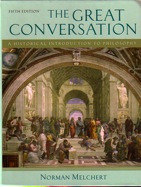
[Aside: You know it must be a great thing to write a standard textbook since one can release a new edition every few years and circumvent all the sales from the campus used book stores
From the OUP Description:
Now in its fifth edition, this historically organized introductory text treats philosophy as a dramatic and continuous story--a conversation about humankind's deepest and most persistent concerns. Tracing the exchange of ideas between history's key philosophers, The Great Conversation: A Historical Introduction to Philosophy , Fifth Edition, demonstrates that while constructing an argument or making a claim, one philosopher almost always has others in mind. The book addresses the fundamental questions of human life: Who are we? What can we know? How should we live? and What sort of reality do we inhabit?
The fifth edition retains the distinctive feature of previous editions: author Norman Melchert provides a generous selection of excerpts from major philosophical works and makes them more easily understandable to students with his lucid and engaging explanations. Ranging from the Pre-Socratics to Derrida and Quine, the selections are organized historically and include four complete works: Plato's Euthyphro, Apology, and Crito, and Descartes' Meditations on First Philosophy. The author's commentary offers a rich intellectual and cultural context for the philosophical ideas conveyed in the excerpts. Extensive cross-referencing shows students how philosophers respond appreciatively or critically to the thoughts of other philosophers. The text is enhanced by two types of exercises--"Basic Questions" and "For Further Thought"--and more than sixty illustrations.
What's new to the 5th edition?
- A new chapter (25) on Simone de Beauvoir and her contributions to philosophy
- New material on Buddhist, Muslim, and Jewish thinkers, including profiles of the Buddha, Avicenna (Ibn Sina), Averroës (Ibn Rushd), and Maimonides (Moses ben Maimon)
- A new profile of Jean-Jacques Rousseau
- Improved translations of several of Plato's works, including Protagoras, Gorgias, Phaedo, Symposium, Meno, and the Republic
- Review questions that are now dispersed throughout the chapters (instead of at chapter ends) to follow relevant passages and facilitate classroom discussion
- Thirteen new images, including seven explanatory cartoons that help students understand key concepts
- A revised Instructor's Manual and Test Bank containing essential points, teaching suggestions, and multiple-choice, short-answer, and essay exam questions
I also appreciate Melchert's respectful treatment of religious subjects. His chapter on Christianity and the meaning of Jesus is quite good, although short. He also gives serious treatment to other Christian thinkers such as Augustine, Aquinas, the Reformers and more in the context of the times in which they lived.
Finally, I've found value in this book that it is not only an introduction to philosophy but serves as a philosophy reader as well. Melchert includes extremely generous excerpts (sometimes numerous excerpts) from philosophers including some complete works as referred to in the OUP description above.
Although written for college level philosophy intro classes, I've recommended this book to others as well who are interested in dipping their toes in philosophy and want something more than Philosophy for Dummies. The book's a bit pricey new, so if you're interested, watch the used market closely. If you want a 5th edition, make sure that is what you are getting before you place your order with 3rd party sellers. Speaking of which, I wonder what I can get for my 4th edition now that it's out of date?
Plagiarism Prevention Can Start At An Early Age

With younger students, plagiarism often occurs out of ignorance. How many of us turned in reports copied out of the World Book Encyclopedia word for word when we were younger simply because no one told us that doing such was wrong? And I admit right here that the first term paper I ever turned in was plagiarized; but at the time (9th grade), I had no idea that what I was doing was wrong. I came into my school mid-year and one of my courses was at an advanced level that required a term paper for higher credit. The other students had written their papers at the beginning of the year with complete instructions on how to do so. When I asked my teacher how to write a term paper, she said that basically I had to use a minimum of six other sources in my paper. So I simply divided the minimum page requirement for the paper into six parts, wrote down information from each book in my notebook, and then had my mother type it up for me (she was a much faster typist at the time). I even listed the six sources on a bibliography page in the back of the book, and did not realize until two years later when we wrote term papers in my junior year English class that what I had done as a freshman was wrong.
I found it interesting in Berg's book that the source of plagiarism for her fictional characters was not the encyclopedia as it was in my day, but the internet. This certainly brings this issue up to date because the main source today for plagiarized texts among students of any age is the internet. When Marion Copied is aimed at elementary age children, but it's almost just as tempting to read it in a college classroom as well.
This is a book you certainly should pick up for your children if they are in elementary grades, and you might even want to consider donating a copy to their classroom or school's library as well.
What Kind of Reader Are You?
| What Kind of Reader Are You? Your Result: Obsessive-Compulsive Bookworm You're probably in the final stages of a Ph.D. or otherwise finding a way to make your living out of reading. You are one of the literati. Other people's grammatical mistakes make you insane. | |
| Dedicated Reader | |
| Book Snob | |
| Literate Good Citizen | |
| Fad Reader | |
| Non-Reader | |
| What Kind of Reader Are You? Create Your Own Quiz | |
Chillingly accurate?
HT: Paul Roberts
Happy Birthday, C. S. Lewis
When I was in college I made it my goal to read everything C. S. Lewis had ever written. I never actually finished that goal, but I read a whole lot of Lewis, especially in those days. In fact, I read so much Lewis in my college days, and his thoughts were so intermingled with mine, that I started getting marked off on my term papers for using British spellings instead of American ones (colour vs. color, honour vs. honor etc.). Yes, I confess that I used a typewriter in college for the first three years for all my writing; I didn't start using a computer until my final year.
I have a great little daily devotional drawn from Lewis' writings entitled The Business of Heaven. The title comes from a statement that Lewis once made, "Joy is the serious business of heaven."
Today's entry comes from one of his best known works, Mere Christianity and is worth repeating here.
I think all Christians would agree with me if I said that though Christianity seems at first to be all about morality, all about duties and rules and guilt and virtue, yet it leads you on, out of all that, into something beyond. One has a glimpse of a country where they do not where they do not talk of those things, except as a joke. Everyone there is filled full with what we should call goodness as a mirror is filled with light. But they do not call it goodness. They do not call it anything. They are not thinking of it. They are too busy looking at the source from which it comes. But this is near the stage where the road passes over the rim of our world. No one's eyes can see very far beyond that: lots of people's eyes can see further than mine.
Between Heaven and Hell

Passing by Matt Perry's blog, I was reminded that 43 years ago today (November 22, 1963) C. S. Lewis, John Kennedy, and Aldous Huxley died (and you thought that thing about deaths coming in threes was a myth!).
A few years back, Peter Kreeft wrote a very charming book in the form of a Socratic dialogue about the conversation Lewis, Kennedy and Huxley had on "the other side" while waiting for their fate. The book appropriately enough is entitled Between Heaven and Hell. Here's how it begins.
Kennedy: Where the hell are we?
Lewis: You must be a Catholic!
Kennedy: You could tell by the accent, eh?
Lewis: Yes. I say--aren't you President Kennedy? How did you get here--wherever here is?
Kennedy: Ex-President, I think: I seem to have been assassinated. Who are you? And--to return to my first question--where the hell are we?
Lewis: I'm C. S. Lewis. I just died too, and I'm pretty sure you're wrong about the location. This place just feels too good to be hell. On the other hand, I didn't see any God, did you?
Kennedy: No.
Lewis: Then it can't be heaven either. I wonder whether we're stuck in limbo.
Kennedy: Ugh! Do you really think so?
Lewis: Actually, I think it is more likely that it's purgatory, especially if we end up getting out of it and into heaven. I did a bit of speculating about such places as a writer, especially in The Great Divorce. I don't suppose you've read it. No...well...But surely you should be familiar with such concepts if you were a Roman Catholic.
Kennedy: Well...I was more of a modern Catholic; I never bothered about transcendental mysteries or mythology. I was too busy trying to take care of the world I lived in for escapist thinking. "One world at a time" as Thoreau put it.
Lewis: You can see now that you were wrong, can't you?
Kennedy: What do you mean?
Lewis: Why, first that it isn't mythology. It's real. Wherever we are, here we are, large as life. And second, that the rule isn't "one world at a time." Here we are in another world talking about our past life on earth. That's two worlds at a time by my count. And while we were on earth, we could think about this world too; that's also two worlds at a time, isn't it? Finally, it's not escapism. In fact, not to have prepared for this journey while we were living on earth would have been escapism. Don't you agree?
Kennedy: Hmm...I suppose you're right. But look! Someone is coming. Can you make out who it is?
Lewis: Why, it's Huxley! Aldous Huxley. Aldous, welcome. How did you get here?
Huxley: Same way you did, I'm sure. I just died. Oh. I say! Kennedy and Lewis! What good company to die in--or live in, whatever you're doing. Where is this place anyway?
Kennedy: That's what we're trying to figure out. Lewis thinks it may be some sort of limbo or purgatory. I'm just hoping it's not hell.
Huxley: Well, you're both wrong. It's heaven. It must be heaven.
Kennedy: Why?
Huxley: Oh this is going to be fun! Lewis you've lost none of your cantankerous penchant for Socratic questioning, have you? I remember you made Oxford a regular hornets' nest when you debated back on earth, and now you've shipped your hornets to heaven. This is a nice challenge.
Lewis: Then reply to it. If everywhere is heaven, then either hell does not exist, or hell is a part of heaven. Which way will you have it Aldous?
Kennedy: Wait, please! Before you two take off, could you please give me some assurances about this sort of debate? I was a debater too, but we politicians confined ourselves to the concrete and the tangible. I'm not all that convinced that you can do anything more than talk through your hat about things you've never seen.
Lewis: So you want an assurance that there is some method of really finding the truth about things we can't see.
Lewis: Yes, indeed. I've been in and out of the back doors many times.
Huxley: You see, Mr. President...
Kennedy: Please call me Jack.
Lewis: That will be rather confusing. My friends call me Jack.
And so it goes for another hundred or so pages. Kreeft's Between Heaven and Hell is a delightful read, but carries many serious themes about the Christian faith as well.
Peter Kreeft. Between Heaven & Hell: A Dialogue Somewhere Beyond Death with John F. Kennedy, C. S. Lewis & Aldous Huxley. Downers Grove, Illinois: InterVarsity Press, 1982.
Philosophia Christi 8.1
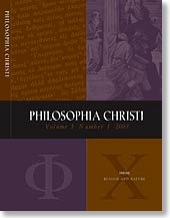
Here are the contents:
ARTICLES:
"Historical Arguments and Dwindling Probabilities: A Response to Timothy McGrew" -- Alvin Plantinga
"On the Historical Argument: A Rejoinder to Plantinga" -- Timothy McGrew and Lydia McGrew
"The Counterattack of the Resurrection Skeptics" -- Stephen T. Davis
"Epistemic Relativism and the Possibility of Religious Epistemology" -- Timothy Mosteller
"Cartesian Anxiety, Perspectivalism, and Truth: A Response to J. P. Moreland" -- Myron B. Penner
PHILOSOPHICAL NOTES:
"Trinity Monotheism Once More: A Response to Daniel Howard-Snyder" -- William Lane Craig
"Natural Uniformity and Historiography" -- John Beaudoin
"What Is Naturalism?" -- Philip E. Devine
"Does Plantinga Have His Own Defeater?" -- Bruce R. Reichenbach and Adam W. Nugent
"Omniscience As a Dispositional State" -- Andrew Cullison
"Ducking Friendly Fire: Davison on the Grounding Objection" -- William Lane Craig
BOOK REVIEWS:
Christopher Peacocke, The Realm of Reason -- Reviewed by Joshua C. Thurow
David Cheetham, John Hick: A Critical Introduction and Reflection -- Reviewed by Paul Rhodes Eddy
David Bassinger, Religious Diversity: A Philosophical Assessment -- Reviewed by Paul Rhodes Eddy
Michael Martin and Ricki Nonnier, eds., The Impossibility of God -- Reviewed by Charles Taliaferro
Erik J. Wielenberg, Value and Virtue in a Godless Universe -- Reviewed by Michael W. Austin
John E. Hare, God's Call: Moral Realism, God's Commands, and Human Anatomy -- Reviewed by David A. Horner
Harry Frankfurt, The Reasons of Love -- Reviewed by John Milliken
Mikael Stenmark, How to Relate Science and Religion: A Multidimensional Model -- Reviewed by James C. McGlothlin
Mary Midgley, Science and Poetry -- Reviewed by Christopher Blakey
Jorge J. E. Gracia and Timothy B. Noone, eds., A Companion to Philosophy in the Middle Ages -- Reviewed by Christina Van Dyke
Lifeway's Hidden Gem: Biblical Illustrator
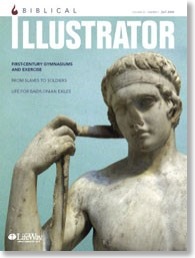
In the title I call Biblical Illustrator a hidden gem because I don't know how many Baptist Sunday School teachers are familiar with it. In fact, I think I'm the only person at my church who uses it. In the church I grew up in, Biblical Illustrator was standard fare among our teachers, but I haven't seen it used as widely in the churches of which I've been a part since coming to Kentucky.
Below is a listing of the contents from the current Fall issue of Biblical Illustrator. One thing you'll notice is that a number of different portions of the Bible are covered. Lifeway produces a variety of curriculums, and Biblical Illustrator provides background articles for three of them. If you've visited this blog in the last week or so, you'll know that the class I teach just started a study on the book of Hebrews. You'll note below that there are quite a few articles to aid my preparation, but I certainly don't mind having the other articles as well. I usually find myself reading the whole issue in addition to the articles from back issues available on the optional CDROM that I'll describe further down below.
|
Article Title |
Author |
Related Text |
|
Daily Life in
Biblical Times by Oded
Borowski |
McLemore, James
D. |
Book Review |
|
The Veil |
Bergen, Martha S. |
Hebrews 6; 9-10 |
|
From Slaves to
Soldiers |
Harris, John L. |
Joshua |
|
What's for
Supper? The First-Century Diet |
Gritz, Sharon |
Hebrews 5:11-6:12 |
|
"Better" in Hebrews |
Booth, Steve |
Hebrews |
|
First-Century
Gymnasiums and Exercise |
Simmons, Billy E. |
Timothy 4:6-16 |
|
Agricultural
Metaphors in the New Testament |
McCoy, Glenn |
Hebrews 5:11-6:12
|
|
Why Are 1 and 2
Timothy So Different? |
Weathers, Robert A. |
1 and 2 Timothy |
|
Who Were the "Officers"? |
Jenkins, David L. |
Joshua 1:1-15;
24:1-31 |
|
The Aim and
Message of Hebrews |
Smith, Argile A. |
Hebrews |
|
The Jordan River |
Register, Dean |
Hebrews 5:11-6:12 |
|
Life for the
Babylonian Exiles |
Hall, Kevin |
Isaiah 40-55 |
|
Moses in the Book
of Hebrews |
Jackson, Paul N. |
Hebrews |
|
Genealogies,
Myths, and Old Wives' Tales |
Chambers, Andy |
1 Timothy 1; 4; 2
Timothy 4 |
|
Seated at the
Right Hand |
Stewart, Don H. |
Hebrews 8:1-9:28 |
|
Ai |
Caldwell, Daniel
P. |
Joshua 7:1-25 |
|
In the Days of
Ahaz |
Newell, James |
Isaiah 7:1-9:7 |
|
Seizing Property |
Young, R. Garland |
Hebrews 10:19-39 |
|
Ephesus Through
Timothy's Eyes |
Gregg, D. Larry,
Sr. |
1 and 2 Timothy |
|
Ancient Weights
and Anchors |
Roark, C. Mack |
Hebrews
6:13-7:28; 12:1-29 |
|
ArtiFACTS:
Biblical Archaeology: Why Does It Really Matter Anyway? |
Drinkard, Joel
F., Jr. |
General Article |
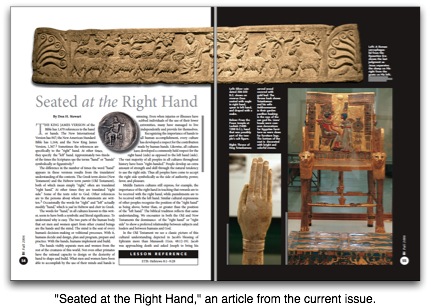
But wait...there's even more. Not too long ago, someone at Lifeway had the great idea to make each issue available on CDROM. Now, if you get Biblical Illustrator Plus, you not only get every article in the print magazine in PDF form but also between sixty and seventy articles from back issues! Each time I get a new copy of Biblical Illustrator Plus, it's like a mini-Christmas for me. Although the CDROM comes with an interface that will run on either a Macintosh or Windows system, that's generally not the way I use it. I move all the articles to my hard drive sorted into folders named after books of the Bible. In merely a year's time, that gives me access to hundreds of articles that I can use not only in Sunday School but other teaching venues as well.
If you teach Sunday School in a Baptist church, this is a must-have resource. However, even if you aren't Baptist, you might find great value in Biblical Illustrator. Subscriptions per year cost $20.55 for the print copy and $34.55 for the CDROM. If you teach in your church, you may be able to ask your minister of education to order this resource for you.
For further information:
• Biblical Illustrator (Print)
• Biblical Illustrator Plus (CDROM)
• Complete Article Index (1974-2006)
More on "Singular They": Step 2.5
1. The change begins in oral speech and informal writing.
2. The change shows up in respectable literature.
3. The change is demonstrated in most grammar books as new editions are published.
The steps above are simply from my observation; but I do have a degree in English, so I've had enough experience in the area to see such things take place.
Not all forms of currently unacceptable English will eventually become acceptable. And just because something's used widely at a popular level still doesn't mean it will become acceptable. "Ain't" has not become acceptable in formal grammar and probably never will. The same goes for most slang. Currently, there's greater laxity toward things like split infinitives and prepositions at the end of sentences, but official acceptance is still slow. And in my opinion, there's nothing wrong with slow acceptance of changes. Ultimately these are rules that we agree upon as a civilized society, and they should not be made too quickly.
The English language, contrary to the wishes of traditionalists, is never static. When I was in college, I took a class in 1988 called "Advanced Grammar," which was actually a fairly enjoyable class despite the name. In that class, our main grammar was Descriptive English Grammar, written in 1931 by Homer C. House and Susan Emolyn Harmon. We used the second edition which was a revision by Harmon published in 1950. Our teacher chose this book because she said she liked it better than any of the current grammar books. However, during our instruction, she regularly told us to ignore this or that rule because it was no longer standard practice. I found this ironic since she had praised the merits of this book so strongly on the first day of our class. Nevertheless, it demonstrated that the English language had changed greatly between 1950 and 1988--so much so that we had to make annotations in our grammar book because it was out of date.
Language has also changed considerably since I was in college. When I was getting my undergraduate degree, masculine universals (man, mankind, he, his--used to represent both genders) were just beginning to be questioned. I remember sitting in an English class where we took a vote that masculine universals were fine and acceptable. The vote was unanimous or very near it--even from the most feminist spirits in the class (and there were a few). I naively thought we had settled the issue, but we had not.
Practically every grammar book published today has sections on sexist language that includes alternatives to words man, mankind, manmade, etc. Even the SBTS style guide has en entire chapter on gender language (see ch. 7, pp. 103-105) which is adapted from the Corporate Editorial Manual of Lifeway Christian Resources. And when addressing their congregations, I hear even the most conservative of preachers using "brothers and sisters," "his or her," and the "dreaded" singular they.
What possessive pronoun would you supply in the sentence below?
Someone left ____________ book in the room.
Very few these days will fill in the blank with his anymore. When I present this sentence to my students, almost all of them will write "their."
As I mentioned above, not all forms of communication in common use will become accepted as standard grammar. The singular they is different, however, because there's a need for it. Here are three reasons why it will become accepted in most standard grammars:
1. The use of "his" (a masculine universal) is no longer standard practice. I notice even the most conservative writers and speakers going out of their way to avoid it. Whether this is conscious avoidance or not, I do not know.
2. There is no inclusive pronoun in English language for reference to humans as there is in other languages, but the need for such usage is part of our day-to-day communication.
3. The use of the singular they goes back hundreds of years in English usage despite the rules of 20th century grammars. Therefore, it has strong precedent.
All of this brings me to the title of this blog entry. Whenever I teach a writing class, we go over this issue as soon as I hand back their first papers. Usually, a large sampling of the papers include the use of a singular they that does not agree in number with the subject in the sentence. I mark such "errors" not to take off points, but because I want my students to think through the syntax of the sentences they are writing. And I jokingly tell them I will quit marking such sentences when the grammar books change their rules regarding the use of the singular they--and I believe they will.
If you have a copy of the Prentice Hall Guide, the reference can be found on p. 117. Surprisingly, this is not in a section on gender/sexist language but in pronoun reference, specifically on indefinite pronouns.
The writers note that "He was traditionally used to refer to indefinite pronouns ending in -body and -one." Then four strategies are presented "to avoid the exclusive use of the masculine pronoun when the reference is to both males and females. This includes the use of "his or her" (personally my least favorite solution) and changing the subject to a plural. But then I saw it: "Use the plural pronoun." An example was cited: "Everyone has their coat."
I was shocked. How long have I been using this book with my classes--three years now? However, then I noticed the disclaimer: "Some people view this as incorrect. Others, such as the National Council of Teachers of English accept this as a way to avoid sexist language."
So, it's allowed, but with a disclaimer--not quite 100% acceptance yet according to Prentice Hall, but acceptable to some nonetheless. Where does this fit in with the three stages of acceptance I described at the beginning of this blog entry? Well, the singular they is at least at a level two because its quickly becoming more used in print--the most prominent example I know of is in the TNIV Bible. Grammar books are starting to discuss it, but wide endorsement is not quite there (yet). But the recommendation to use their as a singular pronoun possessive in the Prentice Hall Guide makes me put its acceptance at a 2.5 (not quite a full "3" because the writers felt a disclaimer was necessary). When future editions of this book and other grammar and usage books allow for it without qualifiers, we'll know that the singular they has been fully accepted.
So in the meantime, I'm still marking it on my students' papers.
*I noticed in looking at Amazon.com that a 6th edition of the Prentice Hall Guide is in print (see link above). My guess is that my students have been receiving this for over a year, but I still have the old edition and didn't even know it was updated. I have requested a new copy.
Trouble with the Tulip by Frank S. Page
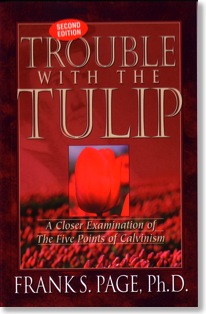
I doubt the book is actually out of print since the second edition (pictured above) has a "2000, 2006" copyright notice. However they must be hard to find, especially if you try to obtain a copy from the publisher's (Riverstone Group Publishing) website.
Here's what I knew:
1. No new copies are currently available from Amazon.
2. The only used copy at Amazon is selling at a ridiculously exorbitant price.
3. I just happened to see the other day that our campus bookstore had four copies.
In the spirit of entrepreneurship, the gears in my head begin to whir (I do have to save toward next semester's tuition, after all). So, as you probably guessed, I now own four copies of the book. I am keeping one for myself and selling the other three on Amazon.com (for MUCH less than the previously used price).
If you want this book, you certainly don't have to buy it from me (there's always the $1,842 copy). However, you should know that in printing the second edition, Riverstone Publishing Group did not change the ISBN, which is a big no-no in the publishing world. So be careful what you order. I can tell you that all three copies I have for sell are in mint condition and all are second editions. They've never been read or even pressed flat. If you would like to get one from me, follow this link to Amazon.com.
Sorry for the shameless plug. Now back to your regularly scheduled blogs...
The Book Store Is Now Open

Therefore, based on some of our recent discussions, I have created a customized page with some of the Bibles I am currently using: "Rick's Bible Tool Belt." And I also created a filtered book page using "wide margin bible" as my filter. If I could customize this page, I would make it match the offerings in the wide-margin Bible survey that I posted a couple of weeks back.
Then I tried to create a software page using the keyword "Accordance," but all the bundles Amazon had said "Currently Unavailable" [Hello, David Lang!!]. Plus my test page also displayed modules from Logos Bible Software. I wanted Accordance, not Logos!
The ability to create more than one customized page would be nice as well as the ability to have more than one filtered category page. However, it is only a beta program right now, and for what it does, it does fairly well.
And of course, yes, if you order something from my page, I DO get a cut. But it's a very minor cut, and you'd be helping out this poor seminary student. So, thanks!
Is Belief in God Good, Bad or Irrelevant?
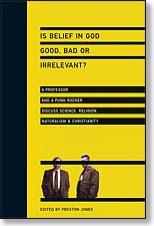
I've read lots of "conversations" between Christians and non-Christians, but I was always troubled that the Christian in the books was so easily able to destroy the arguments of the skeptic as this never seemed to work quite so easily for me in real life. The problem is that in the books, such conversations are usually made up, and of course, the Christian gets the edge. That's not the case with the conversation between Preston Jones and Greg Graffin in the new book Is Belief in God Good, Bad or Irrelevant? from InterVarsity Press.
In this book, we get to read a read another person's email--in fact the email of two people--and it's perfectly okay. The book is described as "A Christian and a naturalist in conversation," and that's exactly what it is. What makes the book so interesting is who these two people are. Representing Christianity is Preston Jones who is a professor of history at John Brown University in Siloam Springs, Arkansas. His naturalist counterpart is Greg Graffin. Now if Graffin's name sounds vaguely familiar to you, it's because he's lead singer of Bad Religion, a punk group whose lyrics tend to be not just anti-Christian, but anti-religion in general. What I didn't know about Graffin until this book is that he has a Ph.D in evolutionary paleontology from Cornell University. Yes, you read that correctly. His dissertation was titled, "Monism, Atheism and the Naturalist Worldview: Perspectives from Evolutionary Biology."
Jones' and Graffin's email correspondence makes for very thought-provoking reading. The book is not a primer in evangelizing the lost as some may be tempted to think, but rather an open-ended dialogue between one person who sees value in religion and another person who doesn't. Neither is converted to the other's opinion by the end of the book, but it is the conversation itself that is of most value.
I should also point out that although Jones initiated the conversation, his writing never makes Graffin come across as an evangelism project. In fact, Jones was a fan of Bad Religion from its very early days in the early 1980's. Since Jones genuinely appreciated the honesty of Graffin's music, his impulse one day to send Graffin an email was done with the utmost respect for the man.
What is contained in the book is an extended conversation that takes place over a a period months, mostly in 2003. While the messages are kept in chronological order, certain themes emerge that form the sections of the book. This won't seem unusual to you if you've ever kept a long-running conversation going with someone through any means of correspondence. Although the conversation is forward going, the topics wax and wane. This is certainly true for this book. The table of contents list a number of conversations including the following: religious inquisitions, hating God, theism vs. naturalism, foundations for morality, the Fall, free will (Graffin does not believe in free will of any kind), Christianity and violence, and proximate vs. ultimate meaning. Other topics are covered as well.
The book also contains a series of intelligent study guides. I call them "intelligent" because these guides are not afraid to ask hard questions regardless of whether one is a theist or naturalist. Further, each study guide comes with research questions which will take a fair amount of preparation on the part of the participants. This is definitely not designed for a "show up and talk about it" group.
The book is a good "get out of your comfort zone" read. As I said, neither person converted the other to his point of view, but I have no doubt the conversation may be ongoing. What is of value is that certain stereotypes about the other's position may by have been dismantled for both participants. Surely Graffin came to realize in his discussions with Jones that there actually are intelligent Christians out there who can hold legitimate conversations about faith, biology, and naturalism. And no doubt Jones was stretched by Graffin as many of his arguments were countered one-by-one.
If there is any evangelistic value to this book, it is to show that to gain an audience with some non-believers, one has to show genuine respect and be willing to communicate openly, honestly and (most importantly) intelligently over the long haul. There is no room for hit and run, cold-turkey evangelism with someone like Graffin. Those are the kind of folks he philosophically and intellectually eats for breakfast.
Inconsistency

The question is this: Why is the NLT okay, but not the TNIV?
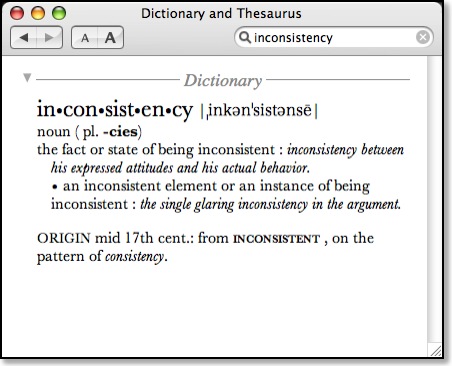
The Parallel Apocrypha
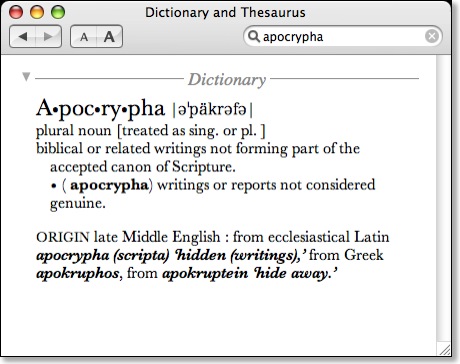
When Martin Luther translated the Bible into his native German, he included the disputed books--commonly known as the Apocrypha--in a section between the Old and New Testaments. In defense of doing so, he added this comment: "Apocrypha--that is, books which are not regarded as equal to the holy Scriputres, and yet are profitable and good to read." Add to that Augustine's sentiment (as quoted in the preface to the KJV) that "variety of Translations is profitable for the finding out of the sense of the Scriptures," and you have The Parallel Apocrypha from Oxford Press.
Although published in 1997, I did not stumble across The Parallel Apocrypha until earlier this year. The book is edited by John Kohlenberger III, who at some point seems to have made parallel editions of just about every combination of the Scriptures imaginable. This work is considered parallel because over a two-page spread (for most texts), the Apocrypha is presented in Rahlfs' Septuagint Greek beside four Catholic translations (Douay, Knox, New American Bible and New Jerusalem Bible) and three Protestant translations (King James Version, Today's English Version, New Revised Standard Version).
Until I obtained this volume, I didn't realize that all traditions do not hold identical lists of what is considered apocryphal (or deutercanonical in Catholic and Orthodox traditions). For instance, Roman Catholic, Greek and Slavonic Bibles all include Tobit, Judith, Greek additions to Esther, Wisdom of Solomon, Ecclesiasticus, Baruch, Letter of Jeremiah, Greek additions to Daniel (Prayer of Azariah and the Song of the Three Jews/Bel and the Dragon), and 1 & 2 Maccabees. But 1 Esdras, Prayer of Manasseh, Psalm 151, and 3 Maccabees are only found in the Greek and Slavonic Bible, but are not in the Catholic Canon. 2 Esdras only appears in the Slavonic Bible and 4 Maccabees appears only as an appendix to the Greek Bible.

Interestingly, the only English translation included in The Parallel Apocrypha to cover all of these books is the NRSV, thus (I assume) making it the most ecumenical translation of the Bible in existence. The only book in the list not to be represented in the Greek is 2 Esdras because no complete Greek manuscript for it exists. Therefore, 2 Esdras is represented with Weber's edition of the Latin Vulgate (alongside only the KJV, TEV, and NRSV).
A very useful bonus to the texts themselves are a number of introductory essays. Judith Kovacs writes on "The Contents and Character of the Apocryphal/Deuterocanonical Books" which provides an excellent introduction to the history, content and literary style of these books. Kohlenberger himself contributes an essay regarding the texts and translations found in The Parallel Apocrypha. If you've ever read any histories of the Bible in English, you may very well be interested in this short history of the Apocrypha in English. Finally, essays are included from a number of different faith traditions: Jewish (Sarah J. Tanzer), Orthodox (Demetrios J. Constanelos), Catholic (John J. Collins), Anglican/Episcopalian (Mary Chilton Callaway), Protestant (Walter J. Harrelson) and Evangelical (D. A. Carson). The addition of these essays helps to take the Apocrypha beyond its status as merely an historical religious document and places it squarely into a faith context.
The book itself is almost 1200 pages long, but the publishers used thin "Bible" paper, so The Parallel Apocrypha is only about one-inch thick. One translation that I wish Kohlenberger included is the Revised English Bible. I would have preferred the REB over the Knox Translation, however, I understand that the Knox Translation is significant because it is a more dynamic translation of the Latin Vulgate and sits well beside the more formal-equivalent Douay version, also from the Vulgate. And I suppose that there was a concerted effort on the part of the editor to include one more Catholic translation (four) over Protestant translations (three included) since these books take a more significant status in the Catholic tradition. Of course, if one considers that there are also renderings of the Apocrypha in the Revised Standard Version and the New Living Translation, it would seem that Protestants often pay more attention to these books than Catholics do themselves. Currently, there is no translation of the Bible in English from the Greek Orthodox tradition, but from what I understand, one is in the works.
In spite of all the Protestant translations in existence, I believe that generally, Protestants are the most guilty for neglecting the Apocrypha. Regarding the Apocrypha, I am in agreement with those who have gone before me in my own faith tradition that these books are not considered to be inspired Scripture. Even the writer of 2 Maccabees admitted as much when he wrote, "...So I will here end my story. If it is well told and to the point, that is what I myself desired; if it is poorly done and mediocre, that was the best I could do" (2 Mac 15:37-38, NRSV). Such sentiment hardly seems up to the level of being "God-breathed."
However, I would agree with Luther that these books are profitable and good to be read for two reasons. First, they are written by believers in the God of the Bible. Just as one might walk into a Christian bookstore and buy devotional literature or even historical fiction, the Apocrypha can be read in the same way (plus, I've always suggested the reading of Tobit to discover where Frank Peretti borrowed his best stuff). Further, and more importantly, the historical books of the Apocrypha, especially 1 & 2 Maccabees fill in the 400 year historical gap between the Old and New Testaments. If it's true that the New Testament cannot be understood apart from the Old Testament, it might be equally true that the culture and the historical situation of Jesus' day cannot be properly understood without the information derived from reading the Apocrypha.
Fire and Ice
Thanatos
sacrifices and libations will do you no good at all.
He has no altar; men do not sing him songs of praise.
Of all the gods Persuasion [πείθω] stays away only from him.
Aeschylus (525/4 - 456 BC), Niobe.
Cited in Anthology of Classical Myth by Trzaskoma, Smith, & Brunet.
Alcimede's Grief
Anyway, I was reading Argonautica yesterday while waiting in the dentist's office. Who wants to read months-old magazines anyway? Anytime I read ancient literature, I am always struck by how different it is in form from modern literature. We as a culture are too impatient, and if we read at all, a work like Argonautica would never--in its present form--hit the bestseller's list--if it even got past an editor's desk to begin with. However, I love it. I love the way the story is told in an ebb and flow style that gives far more detail than what I'm accustomed to before returning back to the main thrust of the story.
Case in point is found in Book 1:260-277 (Loeb numbering) when Jason is about to lead his throng of heroes on their extremely desperate journey. Jason, the ever-popular hero, is surrounded by slaves and freemen, women and men as he prepares to depart. Apollonius paints quite the picture of despair as Jason's mother, Alcimede, wails and throws her arms around him, perhaps as a mother today might do as her own soldier son is leaving for Iraq. "And even as the mother had thrown her arms about her son, so she clung, weeping without stint [limitation]... ." Now, really, we get the picture, don't we? The mother's in tremendous grief that her son is going away on a seemingly doomed journey, possibly never to return. That description alone should be enough, shouldn't it? But Apollonius does not stop there. He creates the most telling and heart-wrenching analogy to describe her grief.
And even as the mother had thrown her arms about her son, so she clung, weeping without stint, as a maiden all alone weeps, falling fondly on the neck of her hoary [aged, white-haired] nurse, a maid who has now no others to care for her, but she drags on a weary life under a stepmother, who maltreats her continually with ever fresh insults, and as she weeps her heart within her is bound fast with misery, nor can she sob forth all the groans that struggle for utterance; so without stint wept Alchimede straining for her son in her arms, and in her yearning grief spake as follows... .
What an incredible description--although I have to admit that if a student in one of my writing classes turned in something like that, I would probably strike through the entire metaphor as being too much and too overdone. But again, different writing styles were appropriate for different eras in history.
Of course, you still have to wonder why Apollonius described Alchimede's grief for her departing son as that of a hopeless young orphaned girl mistreated by her abusive stepmother. I read the passage to Kathy and it jumped out at her, too. She wondered if Apollonius wasn't making a point regarding a particular situation with which he was familiar. Perhaps, but it's all speculation at this point--2,300 years later. Regardless, it's still good stuff for the reader who's willing to be patient and let the story unfold at its own pace. They definitely don't write them like this anymore...
Love Your God with All Your Mind: The Role of Reason in the Life of the Soul (Moreland)
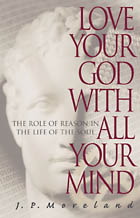
by J. P. Moreland
NavPress, 1997
Guest Review by J. T. McCubbin
I have sat through church services and listened to the outpouring of concern for lost souls. I have been bombarded with messages how, as a Christian, I should continue to seek ways to serve the unchurched in order to demonstrate Christ’s love through us, thereby appealing to the seeker in them, and further enhancing their curiosity about what should fill the obvious void in their life. There is certainly a thread of truth in this mindset, but something seems to miss the mark.
I have also overheard conversations from people at work and other social spheres, about how religion is a private matter to be kept to oneself and within one’s family. After all, what is right for one person is not necessarily right for another. Even we as “Christians” have no place telling, or even urging, others how to behave or believe.
The seeker-centered church presents multiple opportunities to invite my seeker friends and acquaintances to an entertaining church event where they will be exposed to the message of Christ. I don’t have to worry about the discomfort I might feel presenting the gospel to others. All that is required is to get them through the doors and allow the experience to take over from there. In these cases, I have repeatedly failed to fill the seats to which I have been allotted. Upon reflection it occurred to me, first, maybe I don’t have many friends, and second more importantly, I have no friends who are seeking.
Virtually everyone I encounter who is not a Christian has seemingly filled their void with a secular reality, with their individualism, with fulfillment from working toward, or achieving, their personal life goals, and developing the seven habits of overly-stressed people. They are confident in their life-experiences, and they are happy at having fun.
In reading J.P. Moreland’s, Love Your God With All Your Mind, something began to awaken; perhaps my soul even began to stir. After years of being lulled into “God said it, I believe it, and that’s good enough for me,” Moreland’s book passionately cries out for us to become mature Christians and use our minds--to take the first steps of a journey along a path not only to greater accountability, but also loving God in a way that we have long neglected.
Love Your God With All Your Mind: The Role of Reason in the Life of the Soul, is structured into four main parts:
Part One: Why the Mind Matters in Christianity
Part Two: How to Develop a Mature Christian Mind
Part Three: What a Mature Christian Mind Looks Like
Part Four: Guaranteeing a Future For the Christian Mind
In part one Moreland provides the framework for the spread of anti-intellectualism throughout the church and what the result has been. For example, this anti-intellectualism has led to a misunderstanding of the relationship between faith and reason.
While few would actually put it in these terms, faith is now understood as a blind act of will, a decision to believe something that is either independent of reason or that is a simple choice to believe while ignoring the paltry lack of evidence for what is believed. By contrast with this modern misunderstanding, biblically, faith is a power or skill to act in accordance with the nature of the kingdom of God, a trust in what we have reason to believe is true. Understood this way we see that faith is built on reason.
Part one continues by demonstrating how we have allowed our society, media, and education systems to marginalize Christianity. I recognized an example of this shortly after the latest government elections, where the media and late-night entertainers over-simplified the moral based political thought and defined Christian Conservatives as residents of Red states. From my personal experience, these Christians now accept the label and proudly display their newfound label on license plates and bumper stickers. They do not realize how they have allowed their entire belief system and spiritual faith to be wrapped up into a geographical color. This also assumes that because Christians might have morally-based thinking, that they are right-wing conservatives--another set of labels.
Part one also recognizes the reluctance that many Christians might have with a more intellectual structure to a Christian life. Moreland adequately deals with five common misconceptions about a Christian intellectual approach, allowing the remainder of the book to unfold unimpeded.
Part two deals with what Moreland calls the “Hobgoblins, Thieves, and Cobwebs” of our Christian minds. These are the mental enemies we struggle with and how we can begin to gain the upper hand. Dealing with the cobwebs, we dust off our own understanding of reason, logic, and recognizing false argument.
One of the most serious Hobgoblins Moreland contends with is the Empty Self. Reading through the characteristics of the Empty Self, one will recognize many traits indicative of members of our culture. More convicting, one may also recognize traits found within themselves. Overcoming this Empty Self with a “careful intellect,” Moreland argues, is the first step in cultivating a Christian mind.
In the third part Moreland deals with cultivating the Christian mind with a heavy dose of apologetics, and how it can find its place in evangelism. Well-founded apologetic reasoning can then be used to answer the skeptic, the moral relativist, and the philosophical naturalist (scientism). Even for the thought-novice like myself who still has to muster up the courage to rhetorically engage others, understanding these cultural pitfalls allows us to more readily recognize them in our workplace, social circles, and in the entertainment we choose for our family and ourselves.
Finally, in part four Moreland contends with the future of the church with suggestions for recapturing the intellectual life of the church. While in the first three sections, Moreland articulately and appropriately argues for the need for such a recapturing, the suggestions outlined in the fourth section seem to suffer from a superficial element. The suggestions themselves are worth consideration, but only scratch the surface of what may more appropriately require something close to a complete re-engineering. Where the fourth section is redeemed is in the following two appendices full of additional resources for further study. While not diving into these appendices directly, Moreland’s book has more than inspired me to keep studying, digging, reading, and thinking.
For me, Love Your God With All Your Mind has served as a jumping off point into other introductory philosophical reading that has helped me understand the origins of much of today’s flawed secular thinking.
J. T. McCubbin can be contacted at JT.McCubbin@hexionchem.com.
Rick's note: In my opinion, this is one of the most significant books I've read in the last five years. Don't let the title fool you; Moreland's book is not a call to an Ivory-towered, private academic study. Rather, it's a call to Christians in our culture to a life of serious discipleship that among other things, will prepare the believer for encounters with those outside the walls of the church.
Life Together (Bonhoeffer)
by Dietrich Bonhoeffer
Current edition: © 1979, Harper Collins Publishers
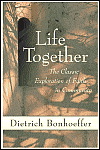
As noted, the book is fairly short--only 128 pages. It's divided into five sections:
1. Community
2. The Day with Others
3. The Day Alone
4. Ministry
5. Confession and Communion
In the first section, Bonhoeffer lays out a theological foundation for Christian community beginning with a quotation from Psalm 133: "Behold, how good and how pleasant it is for brethren to dwell together in unit!" (v. 1). And although starting from an Old Testament reference, the source for Christian community is demonstrated to be in the person and resurrection of Jesus Christ.
Christian brotherhood is not an ideal which we must realize; it is rather a reality created by God in Christ in which we may participate. The more clearly we learn to recognize that the ground and strength and promise of our fellowship is in Jesus Christ alone, the more serenely shall we think of our fellowship and pray and hope for it. (p. 30).
In the second section on the day with others, Bonhoeffer describes how the day should be started when living in community--what he calls common devotions. These common devotions are broken down into Scripture reading, singing together and prayer. Bonhoeffer creates a guide as to how each of these components can be facilitated allowing them to work together. Further, such common devotions should be done before breakfast, what he calls "the Fellowship of the Table." Bonhoeffer goes on to describe how this benefits the days work, and his assumption is that the community or family will be able to join together again for a meal at noon and the end of the day.
Lest anyone should become dependent upon the community as the sole avenue of the spiritual life, Bonhoeffer also has a chapter on individual disciplines, "The Day Alone." See my previous post for a quotation from this chapter where he points out the danger of neglecting community or spending too much time in community. As with all things, there must be a certain amount of balance or moderation. Bonhoeffer goes on to discuss the importance of the individual believer's need for meditation on the scriptures, prayer and intercession.
I was especially intrigued by Bonhoeffer's chapter on ministry. This is without a doubt a chapter that every pastor and Christian counselor should pay close attention. Bonhoeffer was probably writing primarily with the pastor of a church in mind, but I believe his message applies to anyone in a position of spiritual leadership. He has a section entitled "the Ministry of Holding One's Tongue" and another on "The Ministry of Meekness." These sections serve to remind the person in spiritual responsibility of the privilege that it is to work in service to the Christian community. He follows these with a section on "the Ministry of Listening." Here, Bonhoeffer states the following:
The first service that one owes to others in the fellowship consists in listening to them. Just as love to God begins with listening to His Word, so the beginning of love for the brethren is learning to listen to them. It is God's love for us that He not only gives us His Word but also lends us His ear. So it is His work that we do for our brother when we learn to listen to him. Christians, especially ministers, so often think they must always contribute something when they are in the company of others, that this is the one service they have to render. They forget that listening can be a greater service than speakingl (p. 97, emphasis added).
I was also touched by Bonhoeffer's words in his section, "The Ministry of Bearing": "It is only when he is a burden that another person is really a brother and not merely an object to be manipulated" (p. 100).
In the final section on confession, Bonhoeffer seemed to be way ahead of his time on this subject. Way before Promise Keepers or related accountability groups, Bonhoeffer wrote, "He who is alone with his sin is utterly alone" (p. 110) and "If a Christian is in the fellowship of confession with a brother he will never be alone again, anywhere" (p. 115). Of course, he really wasn't introducing anything new at all, but rather reintroducing the value of confession (perhaps lost in reaction to the Catholic Church after the Reformation) and the reality that the average person in sin needs only forgiveness from on high and the firm and loving support of close friends.
If you've ever read The Cost of Discipleship, this books seems to be a natural follow-up, although it is very different in both tone and scope. According to the introduction, Bonhoeffer wrote both books during the same period in his life, so the one naturally flows into the other.
The book was especially meaningful to me because the two areas of concern I have for the church today--and the two areas where I feel I can most contribute--are discipleship and community. These are not something the church has always done well, but something we are called to do, and when done well can be a dramatic foretaste of eternity to come. From conversations I have had over the last year, and from ongoing conversations, community seems to be one of the most sought after, and yet the most elusive gifts the church has to offer. However, if made a priority, community can be a steadfast offering from the church to an ever-changing world. I will be writing more on this subject, including my own journey, in this new year.
One final note. I obtained my copy of Life Together used. There is a personal note written in it, not inside the cover where you might expect it, but on the page facing the first chapter. It is dated September 3, 1998. It reads, "With the prayerful hope that you will find and join and build Christian community. Love Dad." What does it mean that a little over seven years ago a father placed this book in his son's hands and now his son doesn't have it anymore? I don't know. It somehow seems a bit sad. But maybe it can be encouragement for all of us concerned about such things to help fulfill this anonymous father's wish.
Book Sale

Four More Book Reviews Posted: 3 OT & 1 Methodology
These four reviews were written in August 1997 in preparation for the OT Historiographic Literature seminar I took at SBTS.
Alter, Robert. The Art of Biblical Narrative. New York: Basic Books, 1981.
Fischer, David Hackett. Historians' Fallacies: Toward a Logic of Historical Thought. New York: Harper & Row, 1970.
Long, V. Philips, "The Art of Biblical History." In Silva, Moisés, and V. Philips Long. Foundations of Contemporary Interpretation : Six Volumes in One. Grand Rapids, Mich: Zondervan Pub. House, 1996.
Sternberg, Meir. The Poetics of Biblical Narrative: Ideological Literature and the Drama of Reading. Bloomington: Indiana University Press, 1985.
The Value of a Good Book Review
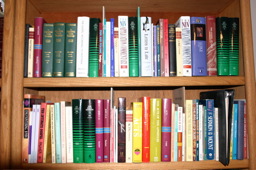
A book review is good for at least three things:
1. It alerts you to a book you did not know about previously.
2. It helps you decide whether or not you actually want to read a particular book.
3. It allows you to understand a book better.
In keeping with the third item, I am going to begin posting my old book reviews in a separate blog arranged by both the date created and searchable by category. I literally have dozens from the various book reviews I've done in classes over the years. The blogging module in RapidWeaver seems to be the perfect medium for making these available as I will post them under the original date they were written, but at the same time categorize them under a number of general headings.
A couple of weeks ago, a student in a class I was grading for at SBTS asked me what I thought was the best way to go about writing a book review. I told him what I was told by Ronald Deering over a decade ago--read other book reviews first. Reading a book review before beginning a new book--especially a more challenging book--is a good way to begin grasping content before you even read it. With that in mind, I'll let Google do its thing and hopefully some of these reviews will appear in various web searches when students, or anyone for that matter, looks for information on a book they need for a class or just for personal reading.
With each of these reviews that I post, I will include the name of the class for which they were originally written. I may at times, choose to cross-post a review written here for my main blog to the book review section as well.
At this time, I am not electing to include comments with these entries--it's not a normal blog after all, but if you feel a need to voice your thoughts about a particular review, please email me at rmansfield@mac.com.
The book reviews can be found as a submenu of Our Library (see link to the top left) or you can simply click here.
Initial reviews posted:
Blenkinsopp, Joseph. The Pentateuch: An Introduction to the First Five Books of the Bible. New York: Doubleday, 1992.
Dockery, David S., and David P Gushee. The Future of Christian Higher Education. Nashville: Broadman and Holman Publishers, 1999.
Fishbane, Michael A. Biblical Interpretation in Ancient Israel. New York: Oxford University Press, 1988.
Marsden, George M. The Soul of the American University: From Protestant Establishment to Established Unbelief. New York: Oxford University Press, 1996.
Noth, Martin. A History of Pentateuchal Traditions. Englewood Cliffs, NJ: Prentice-Hall, Inc, 1972.
Whybray, R. N. The Making of the Pentateuch : A Methodological Study. Sheffield, England: JSOT Press, 1994.
A Few Random Quotes from C. S. Lewis
The Four Loves
"Never, never pin your whole faith on any human being: not if he is the best and wisest in the whole world. There are lots of nice things you can do with sand; but do not try to build a house upon it."
Mere Christianity
"We may ignore, but we can nowhere evade, the presence of God. The world is crowded with Him. He walks everywhere incognito. And the incognito is not always hard to penetrate. The real labour is to remember, to attend, to come awake. Still more, to remain awake."
Letters to Malcom: Chiefly on Prayer
"It was not for societies or states, that Christ died, but for men."
The Weight of Glory, “Membership”
"God gives gifts where He finds the vessel empty enough to receive them."
Taliessin Through Logres, . . . Arthurian Torso, “Williams and the Arthuriad”
Pathyway to Purpose for Women
I first met Linda Graber about a decade ago when her husband Eddie came to take the position of associate pastor at Springdale Community Church . Today, Eddie and Linda are in Parker, Colorado, where Eddie is pastor of the Church at Parker .
Linda has always had a heart for women's ministry, and if you talk with her these days, she will want to tell you about the exciting new series that she has become involved with, Pathways to Purpose for Women. Linda has been in the very first group to go through Katie Brazelton's International Christian Coaching Training for Women. She has currently completed level 1 certification and will pursue the next two levels in upcoming months.
A couple of weeks ago, I asked Linda if she would be willing to write a guest blog entry reviewing the Pathways to Purpose for Women series. Below is her review of all four books.
__________________________________________________________
Dr. Katie Brazelton, Women’s Bible Study Director, Saddleback Church and Founder of the Pathway to Purpose Ministry has written four awesome books for women seeking to connect their to-do-list, passions, and God’s purposes for their life.

Pathway to Purpose for Women is the first book in the series of four published by Zondervan Publishers. In this book Dr. Bazelton has developed an in-depth guide that helps to bring the ordinary realities of one’s life into sync with the extraordinary plans of God. The book is divided into six parts:
1. Step Toward The Pathway (getting your life into sync and leaving the past behind)
2. Never Walk Alone - God’s Fellowship Purpose For You: to connect with others (do what matters today and love others as Jesus loves you)
3. Follow in Jesus’ Footsteps – God’s discipleship purpose for you: to know Christ and become like Him.(pursue peace and repent of all your offenses)
4. Go The Extra Mile – God’s ministry purpose for you: to serve others (wash one another’s feet and walk with integrity)
5. Run To Jesus – God’s worship purpose for you: to magnify Him with you life (expect the desires of your heart and surrender your daily life to God)
6. Point Others Toward The Pathway – God’s evangelism purpose for you: to complete His mission for your life (anticipate God’s vision, take courage, bring glory to God)
Book Two is Conversation on Purpose for Women using 10 appointments that will help you discover God’s plan for your life.
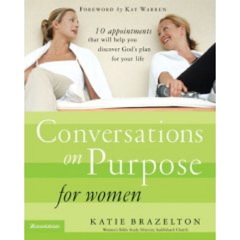
1. The Power of Conversation on Purpose – understanding the power of the process
2. Purposeful Appointments
• Assessing your readiness for more purpose
• Agreeing about the basics of your purposes
• Unearthing blockades to your purposes
• Enjoying the fun side of your unique purpose
• Discussing Good predictors of your future purposes
• Answering some tough questions
• Taking a laughter break
3. Seeing The Bigger Picture
• Making perspective work for you
• Surrendering
• Following God’s Pathway to Purpose
This book is designed for the reader of Pathway to Purpose for Women who want to go deeper. The workbook encourages you to choose a Purpose Partner and schedule ten appointments. Using various conversation starters, scriptures, questions and other methods to help you unpack God’s unique purpose for your life.
Book Three, Praying for Purpose for Women , is described as a prayer experience that will change your life forever.
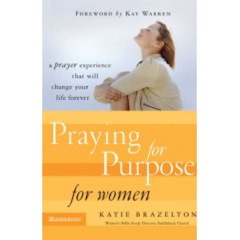
Katie’s God given giftedness and creative communication shines brightly in this incredible sixty day prayer experience. In a world filled with confusion and distraction Katie has created a guide to assist women in developing or enriching their prayer communication with our beloved Pappa God (heavenly Father).
The brief daily readings incorporate stories of ordinary women that God has used to fulfill His purposes in each individual life. Each character has experienced a “define appointment” with their heavenly Father that has given definite purpose for their life. Once the purpose is discovered God is truly honored and glorified.
Each day recalls a biblical story filled with practical application and insights for each situation be it fear, confusion, crisis, success, road blocks, weakness or strength. We find that God’s Word is ageless and always constant.
One will find oneself rushing to the next prayer experience with anticipation and excitement to read the experiences that God has allowed in many different lives. Each experience has definite purpose that the reader can relate to in their individual life.
What an exciting beginning to a discovery process of one’s life purpose revealed in prayer with Pappa God.
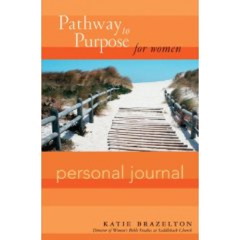
Katie Brazelton is the founder of the Pathway to Purpose Ministry . She has established and launched an international life coaching training for women desiring to find their purpose and become equipped to coach other women step-by-step in the discovery of their purpose.
Linda Graber is available as a women's retreat leader and can be contacted at lmgraber@comcast.net
The Five Dysfunctions of a Team by Patrick Lencioni
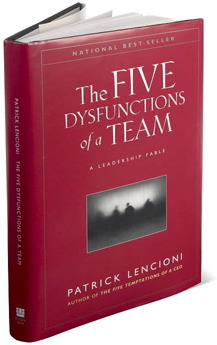
Guest review by Jason Snyder
The Five Dysfunctions of a Team
by Patrick Lencioni
2002, Jossey-Bass
All of us have experienced a grand lie early in life. We were the victims of a school system that conditioned us to believe that success is merited by individual achievement—the grade! Then we join the work force and learn the truth, that the success of our company or organization depends upon our ability to work with a team to achieve results. It is no surprise that teamwork doesn't come naturally. Why do so many teams fail to realize their full potential?
In classic leadership fable style, Patrick Lencioni addresses five key dysfunctions that must be overcome to achieve success. Why do teams fail? The first dysfunction is that people choose individual status over achieving group results. Why don't teams achieve results? The second dysfunction is that team members choose popularity over accountability. They fail to hold one another accountable for bad behavior and lack of team results. Why is accountability difficult to attain? It's because of the third dysfunction, that people fail to commit to decisions. It's hard to hold someone accountable to a decision you haven't committed to. Why are people unwilling to commit? The fourth dysfunction is the fear of conflict, choosing false harmony instead. People fail to engage in unfiltered, productive, ideological debate, and because their opinion was never heard, they don't want to commit to someone else's decision. Why do people fail to enter into conflict? The final dysfunction is that there is an absence of trust among team members who choose invulnerability instead.
The cornerstone of every organization is teamwork. Teams can thrive whenever there is trust which leads to a healthy environment of conflict which leads to committing to decisions which leads to holding one another accountable which leads to accomplishing group results.
Feel free to contact Jason Snyder at snymo@mac.com .
Toxic Faith by Stephen Arterburn and Jack Felton
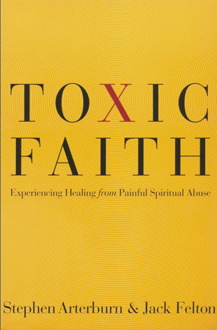
Guest review by Jason Snyder
Toxic Faith: Experiencing Healing from Spiritual Abuse
by Stephen Arterburn and Jack Felton
2001, Shaw
How do you boil a frog? The answer is as simple as it is sinister: put it in a kettle of warm water and turn up the heat slowly. A frog pitched into boiling hot water will always jump out.
I recently left a church environment that grew in toxicity over a long period of time. It wasn't until I left that I could fully see the spiritual bankruptcy and leadership failure that enabled a toxic faith.
The authors of Toxic Faith detail 10 key characteristics of a toxic faith system as well as describing key beliefs and players in the system. Is the faith environment you live in characterized by...
1) Special Claims: the leader has some special knowledge, ability, or wisdom that makes him unique or special.
2) Authoritarianism: the leader is dictatorial and beyond question.
3) An "Us vs. Them" Mentality: members always set themselves in sharp contrast to other religious movements.
4) Punitive Nature: critics and those who question are isolated, removed from leadership, and even asked to leave.
5) Overwhelming Service: members are asked to give arduous service, to sacrifice, to be totally committed.
6) Follower in Pain: members are often physically ill, emotionally troubled and spiritually dead.
7) Closed Communication: communication is controlled at the top level and moves down, going only one way.
8) Legalism: the system is based on rules which bypass a meaningful relationship with God and distort God's purposes.
9) No Objective Accountability: the leader asserts he is only accountable to God.
10) Labeling: labels are used to discount those who may question or oppose the toxic faith system.
Arterburn and Felton share real world experiences and give hope that there can be health and healing on the other side of spiritual abuse.
Contact Jason Snyder at snymo@mac.com .
Overdue Books
Finally, after a lot of work, our library is back in order with everything where it should be on the shelf... almost. I have a few books that are missing, and there's a good chance that perhaps someone reading this will remember that I loaned you this or that particular book. You don't necessarily have to give it back immediately, but if you would be so kind as to let me know you have it, so that I don't have to order a replacement.
Here are the books that are missing:
• Watts, Isaiah 34-66 (Word Biblical Commentary)
• Foulkes, Ephesians (Tyndale New Testament Commentary)
• Hull, Jesus Christ Disciple-Maker
• McDowell, The Islam Debate
• Blomberg, Interpreting the Parables
• Stein, Introduction to the Parables
• Morris, Apostolic Preaching of the Cross
If you would like to see our complete list of books, now that they are in order, go to our library page on my main website.
As I said, if you have my copy of any of the above books, please let me know. Thanks!
The Last Disciple by Hank Hanegraaff and Sigmund Brouwer
Take -THAT-, Tim LaHaye...
Opening an apocalyptic can of worms...
I was a teenage Dispensationalist...
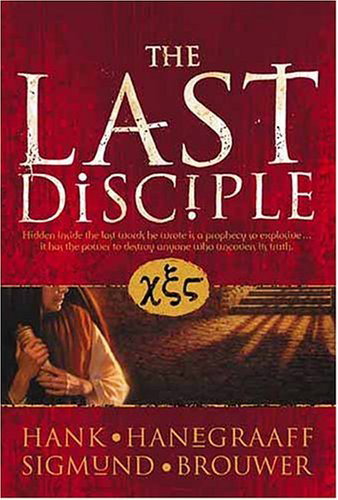
The book itself is a pretty good page-turner (I read it in no particular rush as bedtime reading in about two weeks). The protagonist of the story is a member of Nero's close inner circle named Vitas. Although a number of characters in the book are actual historical figures, Vitas is not. In the story, Vitas is increasingly troubled by the paranoid Nero's persecution of Christian believers. Although not a believer himself (at least in what's been published so far) Vitas finds himself in the middle of a spiritual struggle made even more complicated by his love for a freed Jewish slave, Sophia who is herself a believer in Jesus of Nazareth. The story takes place on a number of fronts in the Roman Empire, but primarily goes back and forth between first century Rome and Jerusalem.
I liked this book, and I don't want to reveal too much of the story. The authors have carefully constructed a tale that will appeal to both men and women. To speak in great generalities, there's enough action, fighting, and intrigue to keep male readers interested while the romantic threads that run throughout the story will keep any female reader turning pages as well. And regardless of your gender, if you are a student of John's Apocalypse, ancient history--especially Roman history--there's more than enough here to keep you interested.
As hinted at above, there's a little bit of controversy to this book, in more ways than one. First, from a theological perspective, Hanegraaff & Brouwer's Last Disciple takes a viewpoint completely contrary to the Tim LaHaye and Jerry Jenkin's Left Behind series. More than that, both The Last Disciple and Left Behind are printed by the same publisher, Tyndale House ! Word is that Lahaye is furious at Tyndale for publishing an opposing viewpoint. "They are going to take the money we made for them and promote this nonsense," said Tim Lahaye in an article first appearing in the Dallas Morning News.
In a nutshell, LaHaye's Dispensational Premillennial view says that at some date in the future, Jesus will return to take all believers away (known as the "Rapture") in an event that inaugurates a seven-year reign of terror by the Antichrist. This will end in an apocalyptic showdown between the forces of good and evil where Jesus will return and institute a thousand year rule, after which Judgement Day will occur when believers will enter into eternal glory and unbelievers will be cast into the Lake of Fire. Whoops, I just ruined the ending for those of you reading the Left Behind series. My apologies.
Hanegraaff and Brouwer are coming from a perspective known as Partial Preterism. If you've never heard of this, let me explain. Preterism says that the events described in the Book of Revelation have already taken place in the first century. The tribulation is the persecution of the church in the fifties and sixities of the first century, and Nero is the Antichrist. The Book of Revelation itself is written in a code based upon Old Testament symbols so as to keep it's message a secret from the Romans. A full preterist believes that everything that is described in the Book of Revelation has already taken place. A partial preterist such as Hanegraaff will distinguish himself by saying that not all of the things described in the last book of the Bible have yet occurred. Believers are still looking forward to the bodily return of Christ, the resurrection from the dead, and the judgment before entering into eternity, according to the partial view.
I grew up in a tradition that primarily espoused LaHaye's viewpoint of dispensationalism. Many Christians go through a time in their lives when they are overly fascinated with these issues. For me, it was when I was in high school, around my senior year. In seeking to understand the end times better, I read the leading authority of the day, Hal Lindsey. I read The Late Great Planet Earth (which, incidentally was the top-selling book, Christian or secular, of the 1970's), Lindsey's commentary on Revelation, There's a New World Coming, and of course, The 1980's: Countdown to Armageddon.
But the more dispensationalism I read, the less I seemed to buy it. Primarily as a sticking point for me was this idea that Jesus was going to come back in this secret second coming and take all the believers away seven years before his real second coming. I could not and still cannot find any biblical warrant for anything like this. Later I would learn that the idea of a "rapture"--rescuing all believers from the tribulation--is essentially new theology, originating from the mid-nineteenth century with John Darby who was a huge influence on Charles Scofield of the Scofield Bible. These were to influence 20th century individuals such as Charles Ryrie, Hal Lindsey, Tim LaHaye and others who have championed and promoted dispensationalism to the point that it is a predominant view among evangelical Christians. Although I don't consider it heretical, I have to remind people that it is not historic Christian belief.
There is one part of The Last Disciple in which Hanegraaff and Brouwer poke a bit of fun at the Left Behind series. The "last disciple" refers, of course, to the Apostle John who doesn't even appear in the book until well into the last third of the story. On p. 318, Hanegraaff and Brouwer write:
John continued to smile. "I'm sure that all believers would wish to be whisked away, taken up into thin air, to avoid the Tribulation. Yet that would be a false hope, especially if it replaces the true hope of the Resurrection, for the resurrection of Jesus and the resurrection promised to us because of it are what give us the hope to endure troubles. In this age. In any age, even should it take thousands of years for the Second Coming."
Personally, I am respectful of the partial preterist viewpoint more than dispensationalism because preterism treats the historical context behind the biblical text seriously. However, I think there is a midway point that I prefer. As I began to reject dispensationalism in my late teens, I began to form my own understanding and later I found a particular perspective that matched what I had understood from my study of the Bible quite well. It is known as Historical Premillienialism. If anything it is a midway point between the two options already discussed here. First of all, it does treat the historical realities behind the Book of Revelation seriously as does preterism, but it also looks to a future time of heightened persecution and an extremely godless individual who sets himself up as a messiah, and seeks self-worship, and self-exaltation. Historical premillennnialism rejects the idea of a secret rapture of the church, but rather says that believers will go through the tribulation before the second coming of Christ.
Biblical prophecy can have layers or multiple fulfillments. So in Hosea 11:1, the prophet can say "Out of Egypt I called my son" referring to the Exodus, but it also has further implication in regard to the Messiah as noted in Matthew 2:15 when Joseph hides Mary and the infant Jesus in Egypt to escape Herod. In Isaiah 7:14, we read "and a virgin [Hebrew, almah] will conceive and give birth to a son." This prophecy had immediate implication for King Ahaz, but it also had significance regarding the Messiah to come as noted by Matthew in his Gospel (Matt 1:22-23). This is--in its truest sense--prophecy being fulfilled which comes from the idea of being filled full. There can be layers to prophetic writing. This can certainly make it difficult to interpret, but it keeps us watchful and humble as we approach the Scriptures and the events that take place in the world around us. Unlike dispensationalists, we are careful not to jump to conclusions in interpreting current events and we would certainly avoid setting any dates for the return of Christ which has become fairly popular with dispensationalists over the last two centuries.
So, although I am respectful of Hanegraaff's position--much more so than LaHaye's--I would have to find a median position that treats seriously the history behind the Book of Revelation, but still looks for events to take place. Hardly anyone disagrees that through the ancient number game of gematria where letters of the alphabet stand for numbers (explained in detail in the book), the number 666 clearly says Neron Caesar. Even dispensationalists like LaHaye will admit this. And here I would agree with them that Nero formed the prototype for the antichrist--one who is absolutely opposed to God and his people. And yet, there is one like Nero, perhaps you could say, in the spirit of Nero who is still to come.
Besides interpretational differences, the only real problem I have with The Last Disciple is that in order for it to really work, the Book of Revelation has to have been written in the early sixties of the first century. Although I believe that most of the epistles were written in the fifties and the Gospels in the late fifties or in the sixties (before the destruction of the Jerusalem Temple), I have a hard time believing that John's Apocalypse was written this early. Almost all evangelical scholars and church tradition beginning with Irenaus has placed Revelation as being written during the reign of the Emperor Domitian around AD 90. There are a number of issues surrounding this that I am not going to go into here right now, but I think this is a monumental issue with Hanegraaff's argument.
I do recommend the book though. The Last Disciple reminded me how central the resurrection of believers is to the hope that we have for the future. The first century Christians were willing to face death in the Roman coliseum so bravely because they knew that their physical death was not the end. They knew that they were coming back, and coming back in bodily form. This is our hope for the future, not some secret rescue before things get really, really bad.
I admit up front that I have not read ANY of the Left Behind series, but if you have or even if you haven't, The Last Disciple will introduce you to a lot of history and background that sets the context for the New Testament. One word of warning: there are some highly graphic descriptions in the book relating to the cruelty of Roman persecution. But the Roman persecution, like many of the events in the book are grounded in reality as opposed to some books grounded in pop-theology and speculation.
Happy Birthday, C. S. Lewis

When I was in college, I was practically obsessed with C. S. Lewis. My goal was to read everything he wrote (something I gave up a long time ago). I read so much Lewis back then that I often got marked off in term papers for using British spellings (favour instead of favor, analyse instead of analyze, etc.). For the longest time, beginning in college and even into my first year or two in seminary, I managed to use at least one Lewis quotation in every paper I wrote. But that got a bit old, if not forced after a while.
C. S. Lewis died on November 23, 1963 which just so happened to be the same day that John F. Kennedy and Aldous Huxley (Brave New World) also died. A few years ago Peter Kreeft wrote a fictionalized account of the conversation of the three on the other side while they waited to stand before God. The book is entitled, Between Heaven and Hell . It makes for a pretty good read on the differences in worldviews of Lewis, Huxley, and Kennedy.
By the way, Perry Bramlett, one of the world's foremost experts on all-things-Lewis, lives right here in Louisville, Kentucky. He speaks year-round at churches and literary groups around the country. If you would like information about his ministry or want to consider booking him for an event, check out his website .
Celebrate C. S. Lewis' birthday by reading The Lion, the Witch, and the Wardrobe to your child or even to yourself. He would like that. Read (or reread) Mere Christianity or The Screwtape Letters. Or if nothing else, insert Shadowlands into the DVD player for a pretty good Hollywood adaptation of the latter part of Lewis' life.
I wonder what other notable people were born on November 29?










